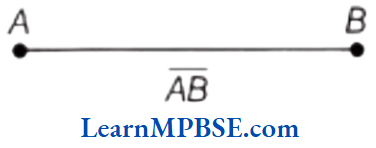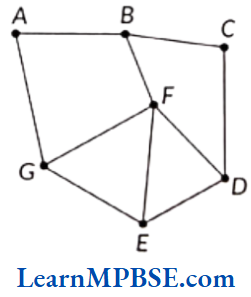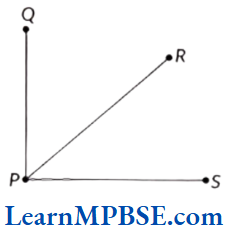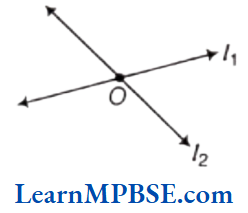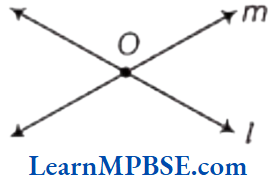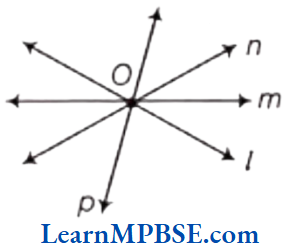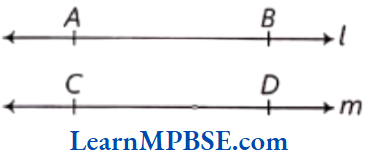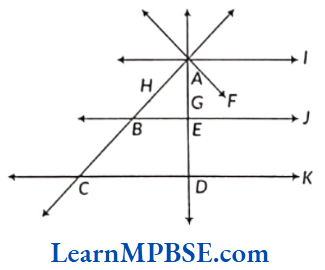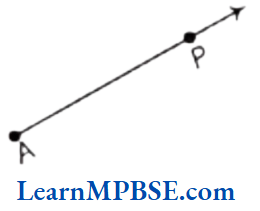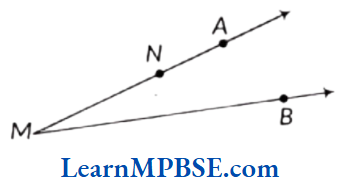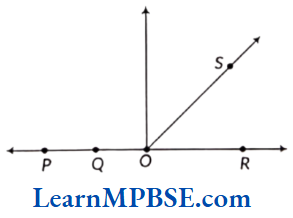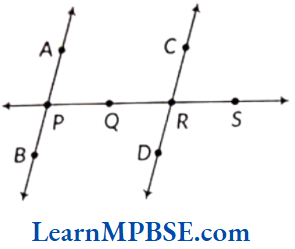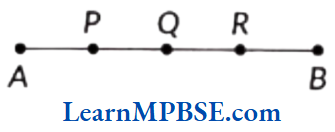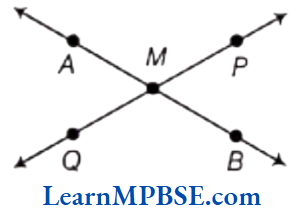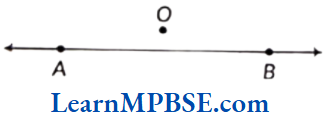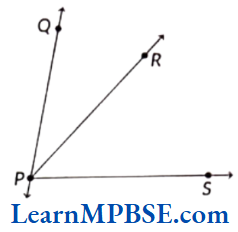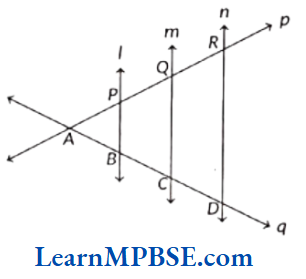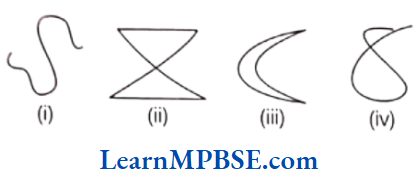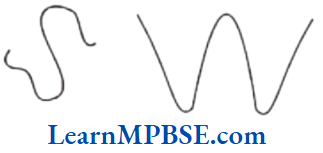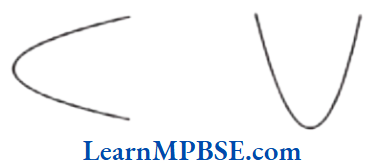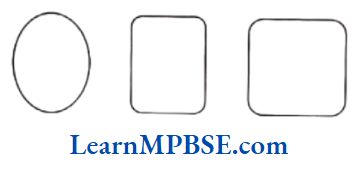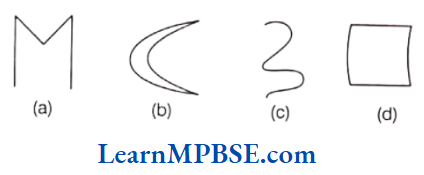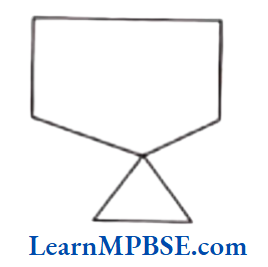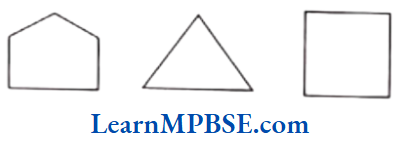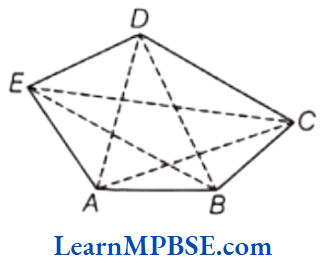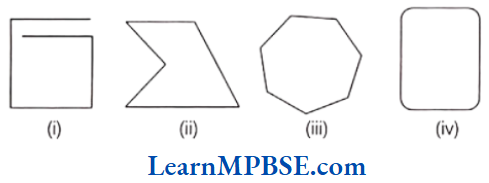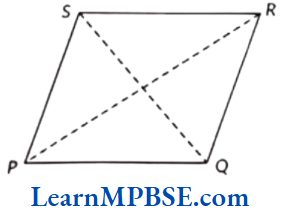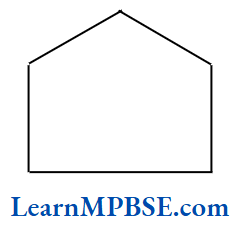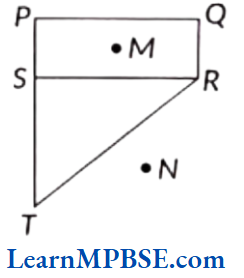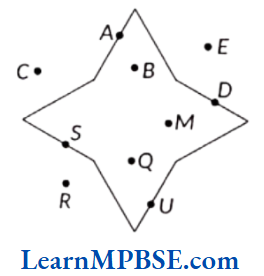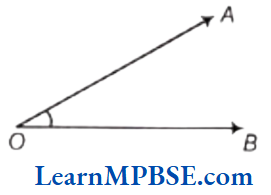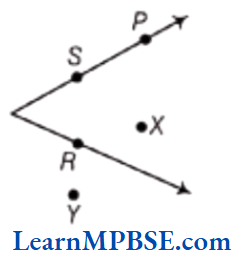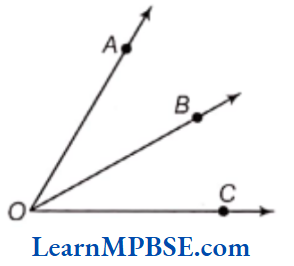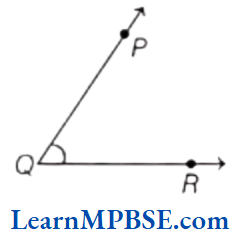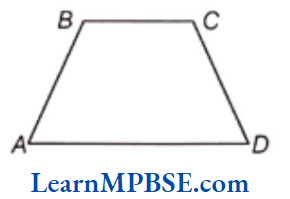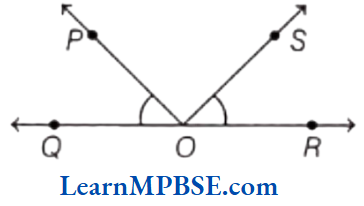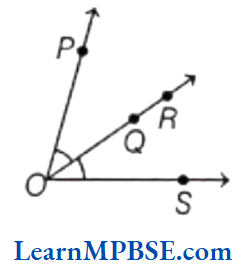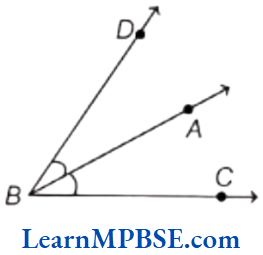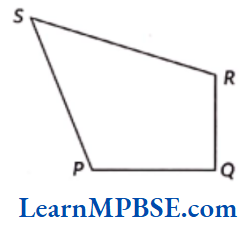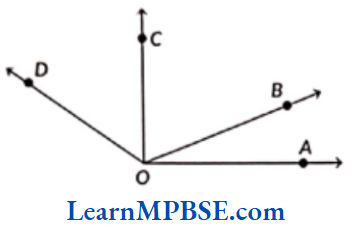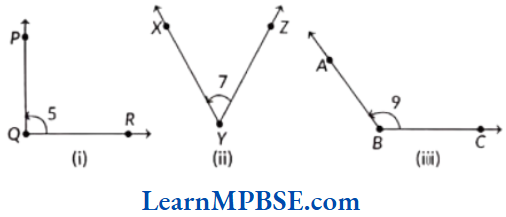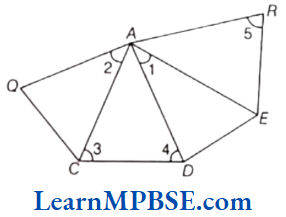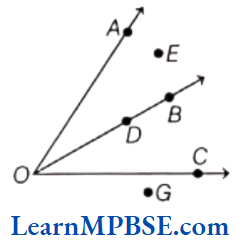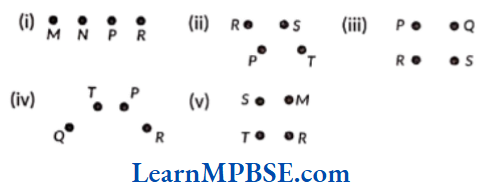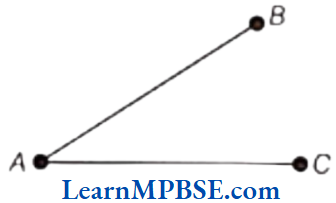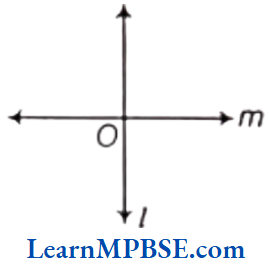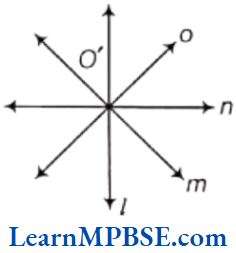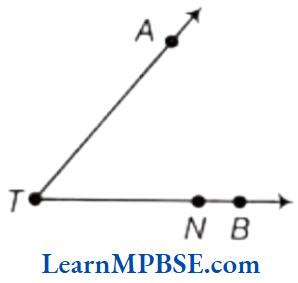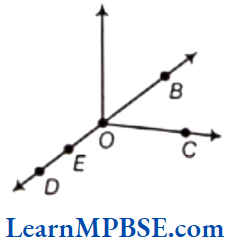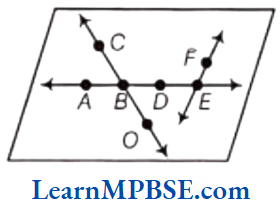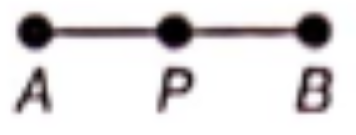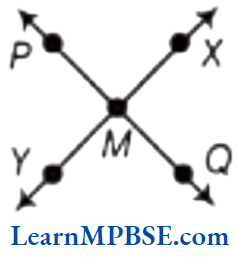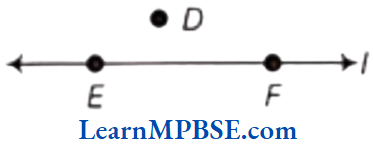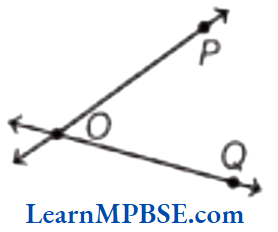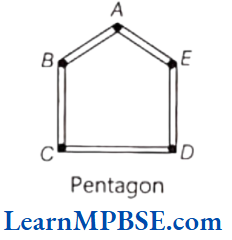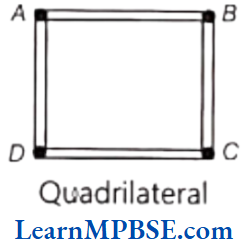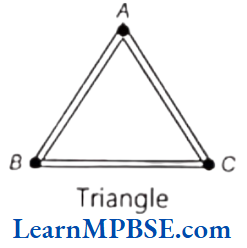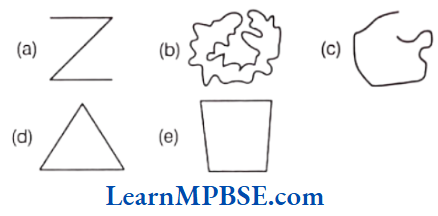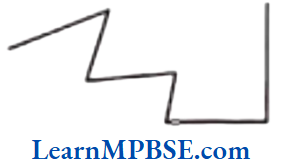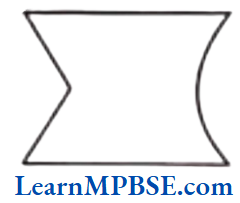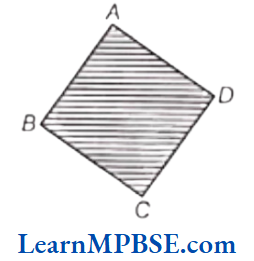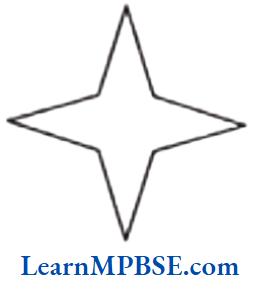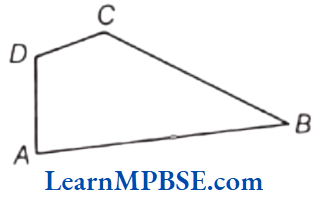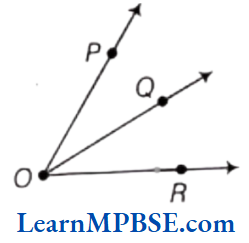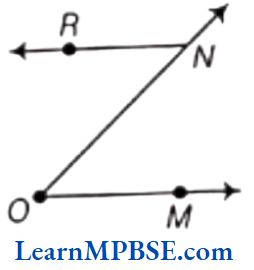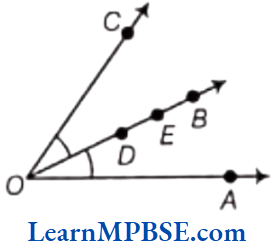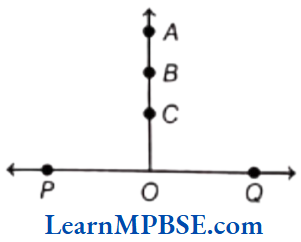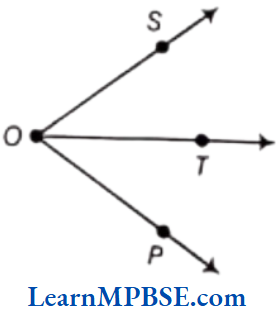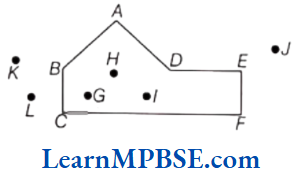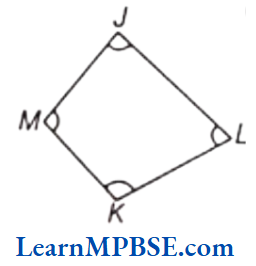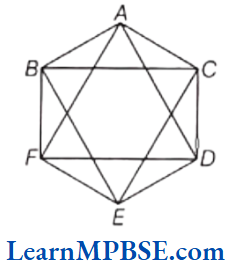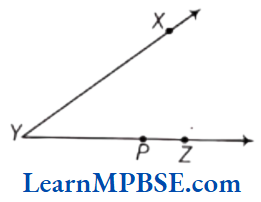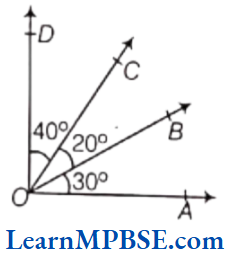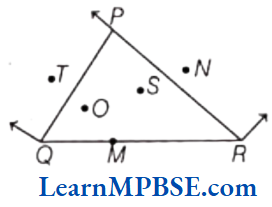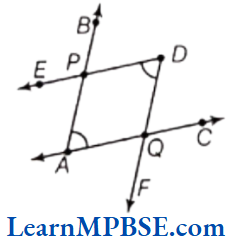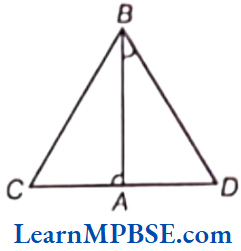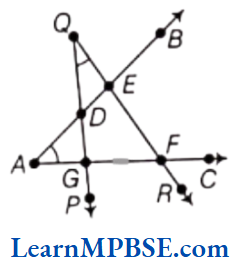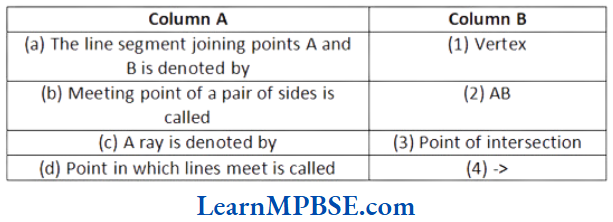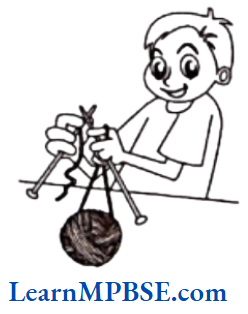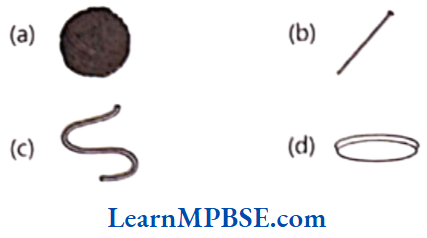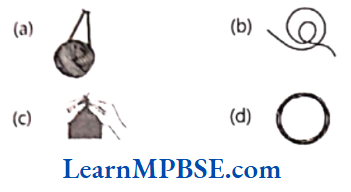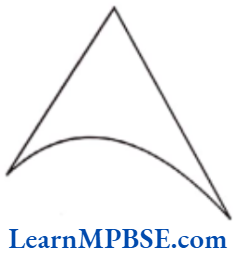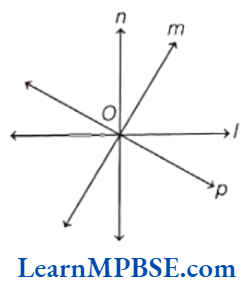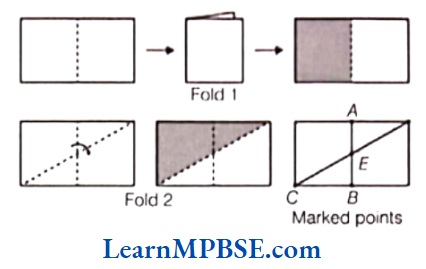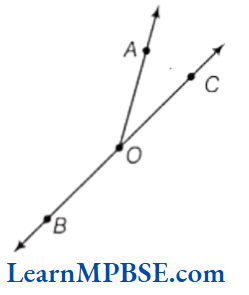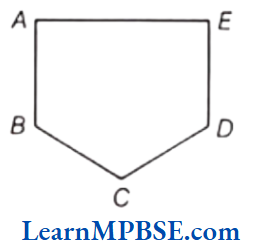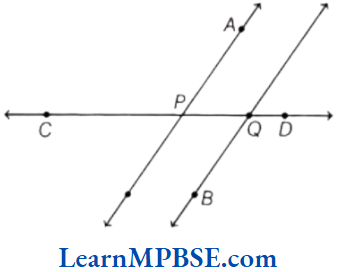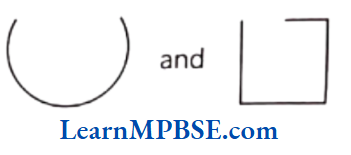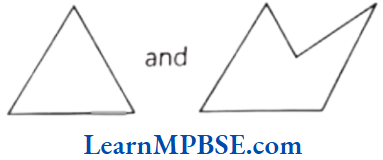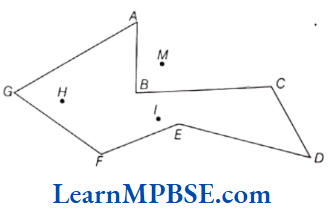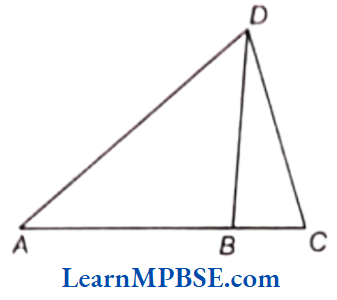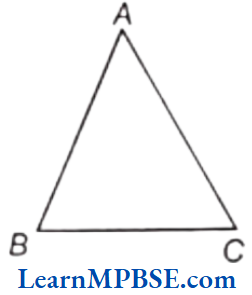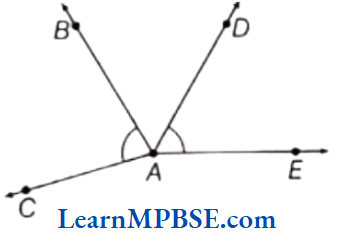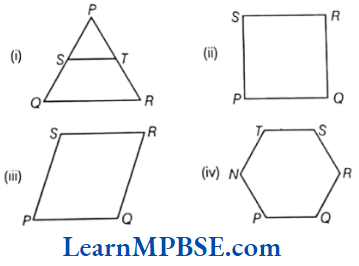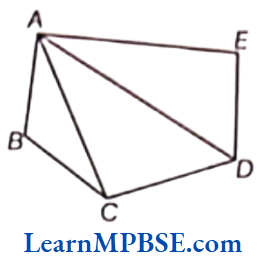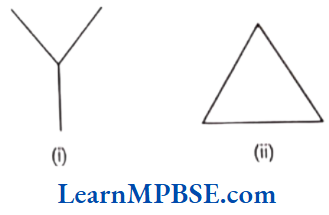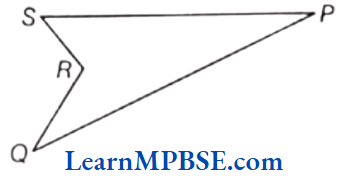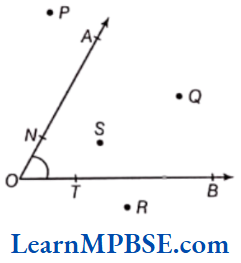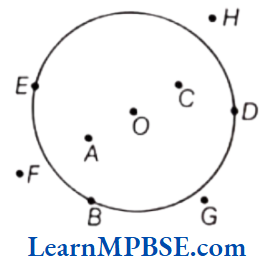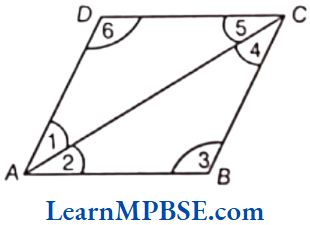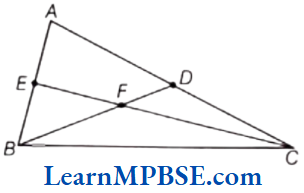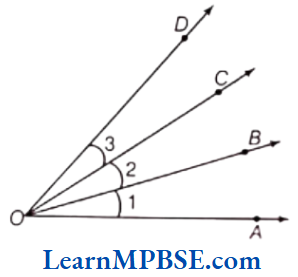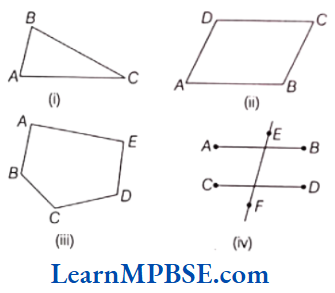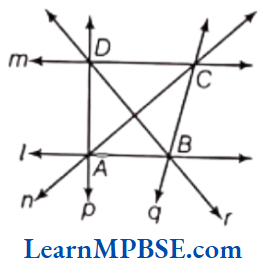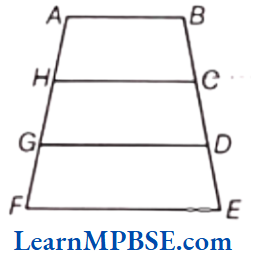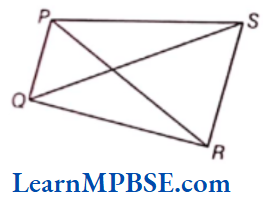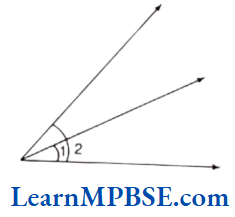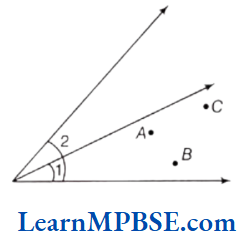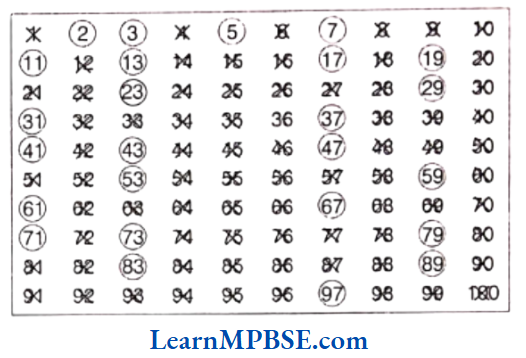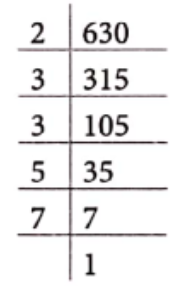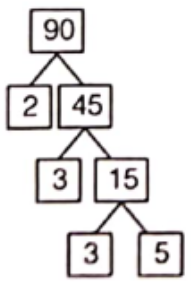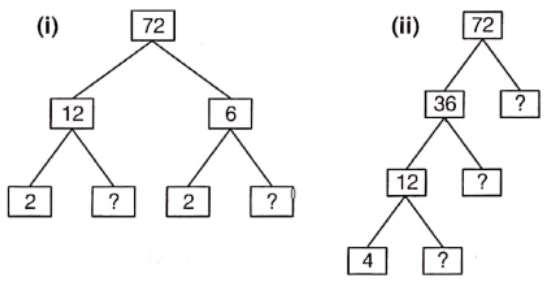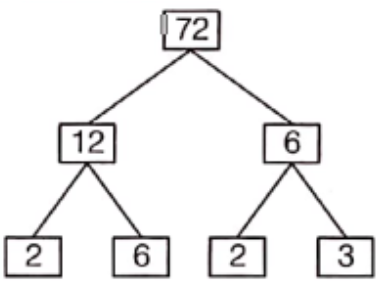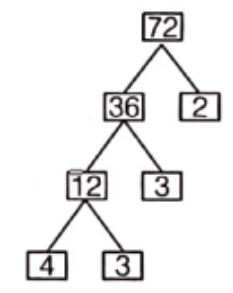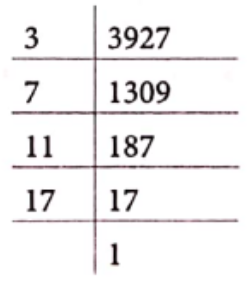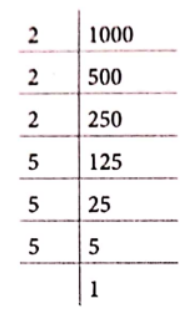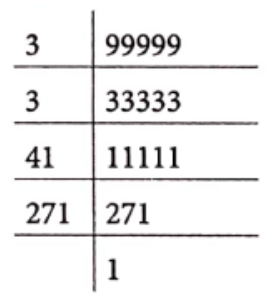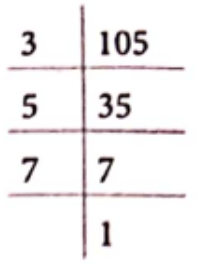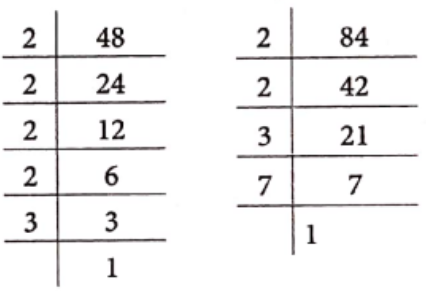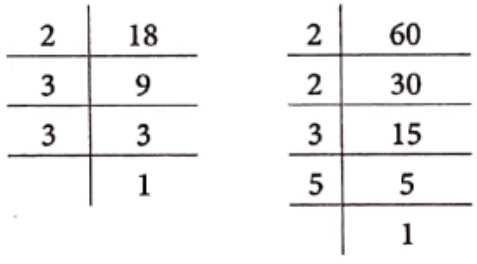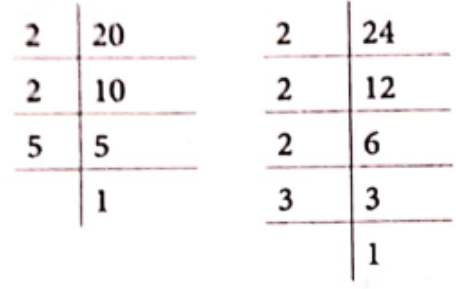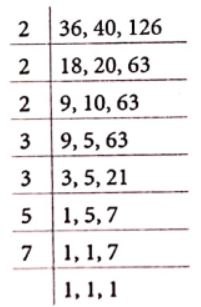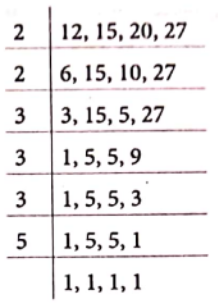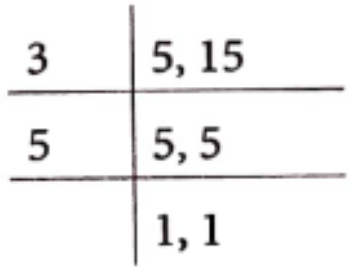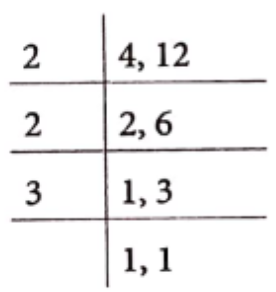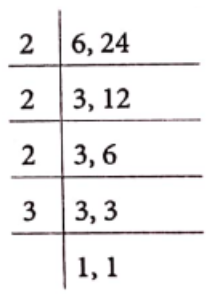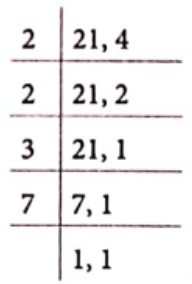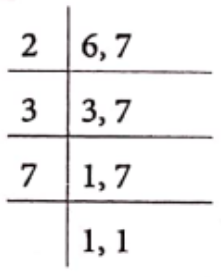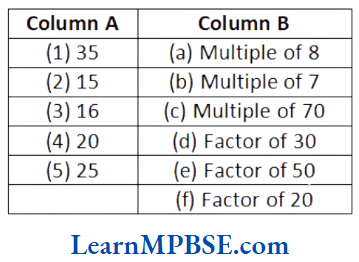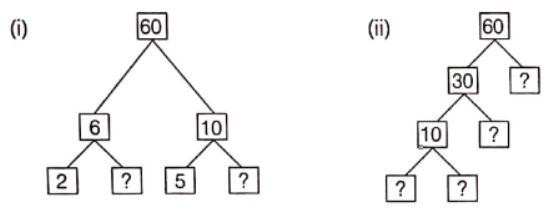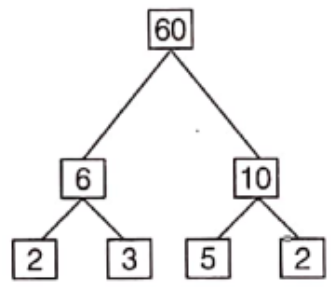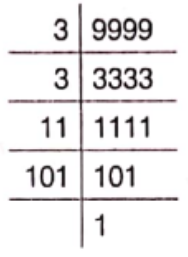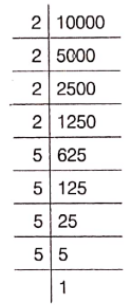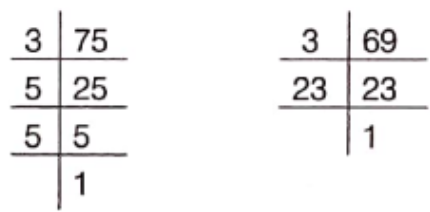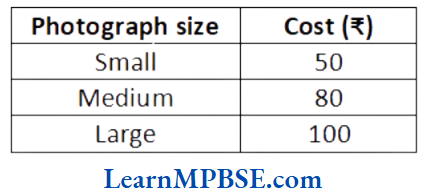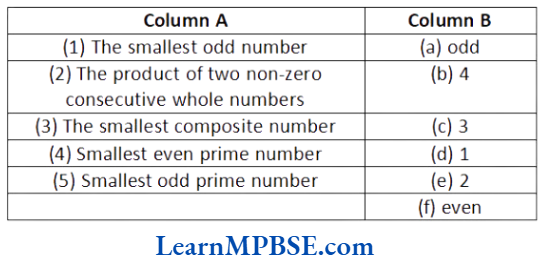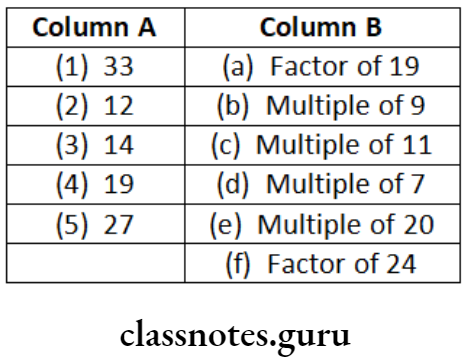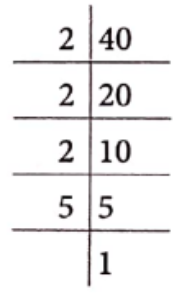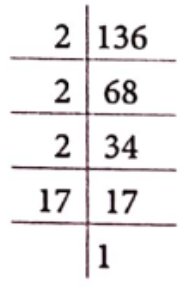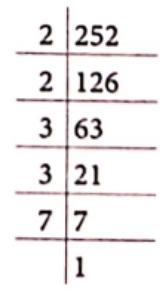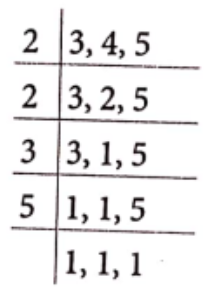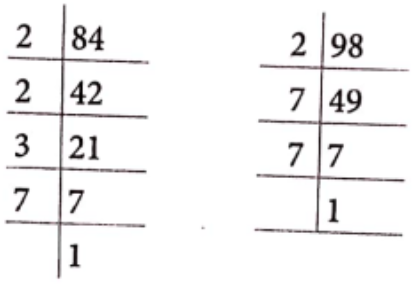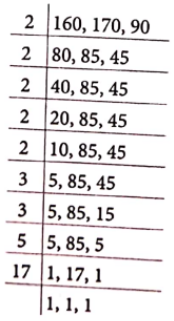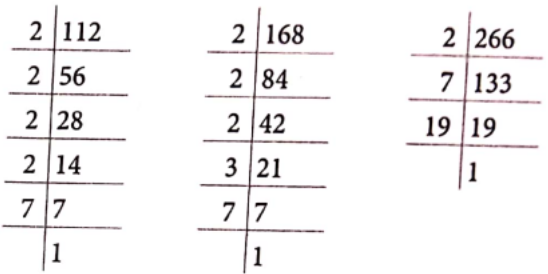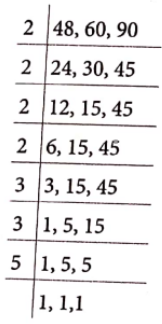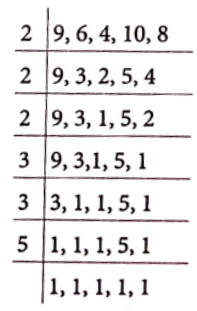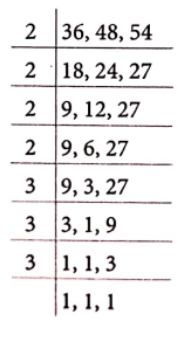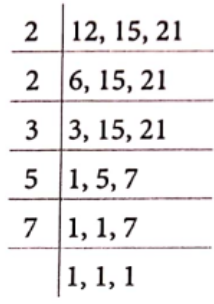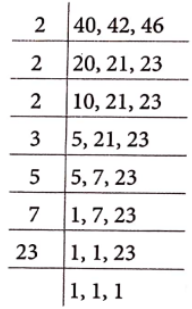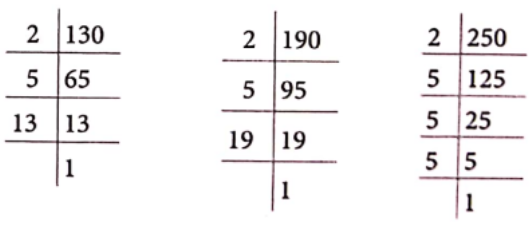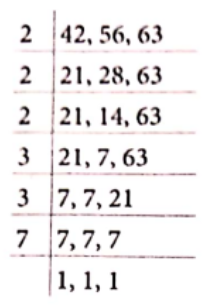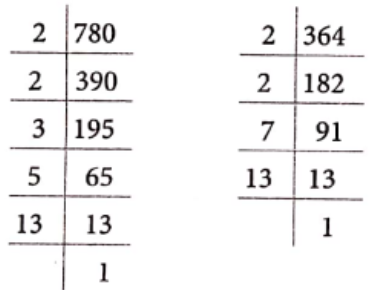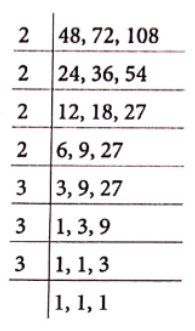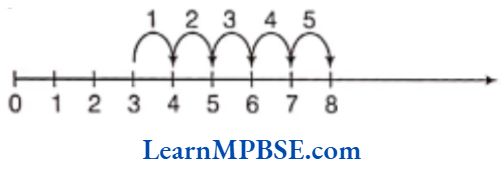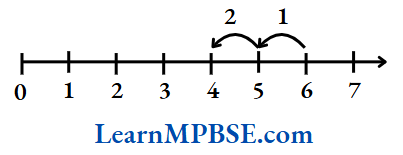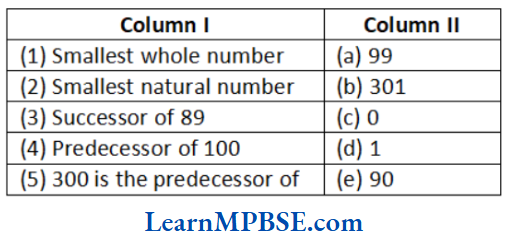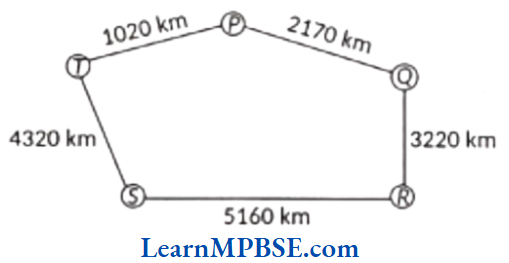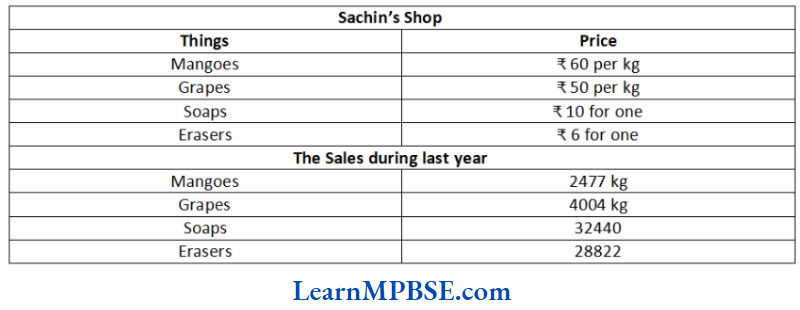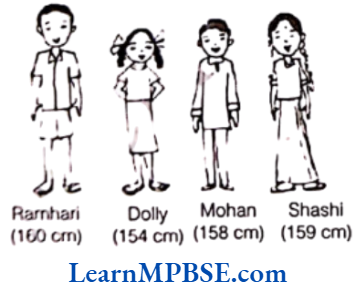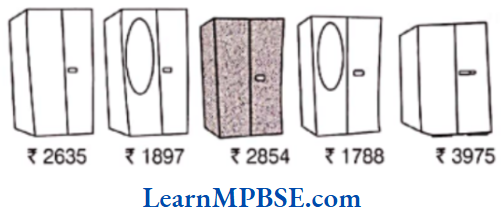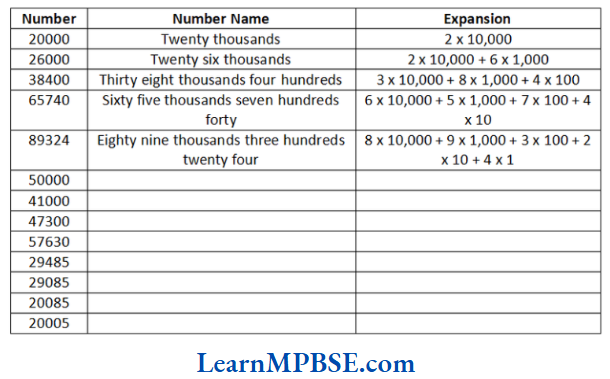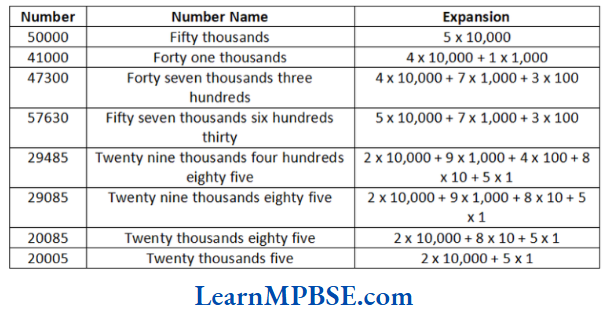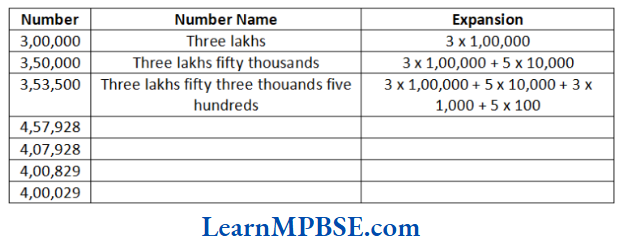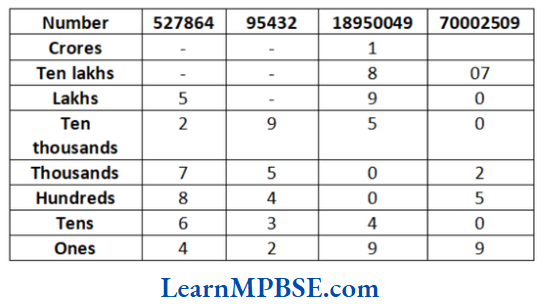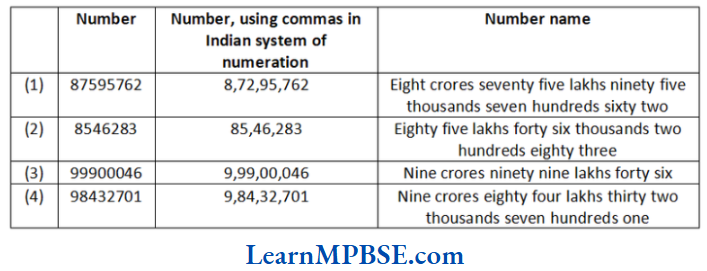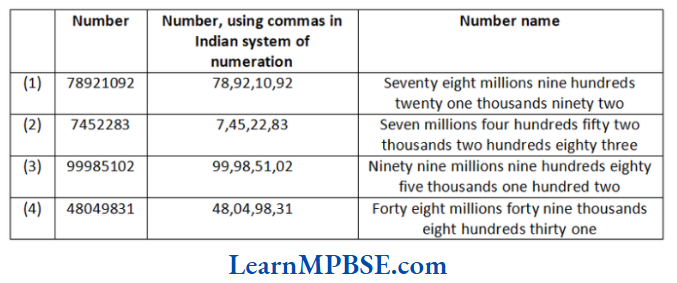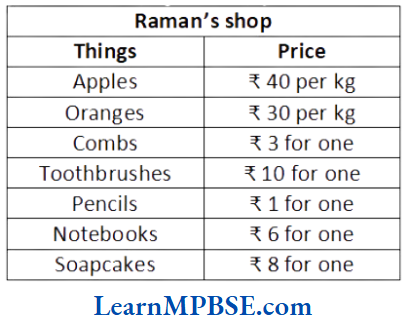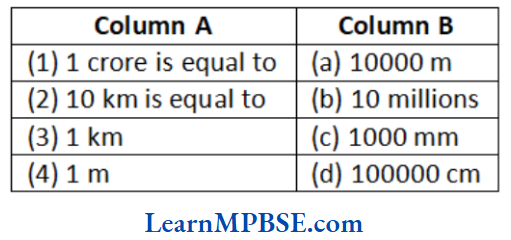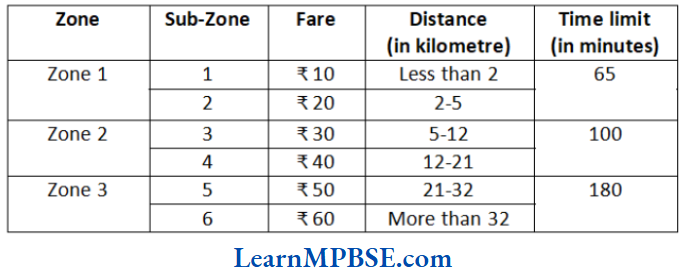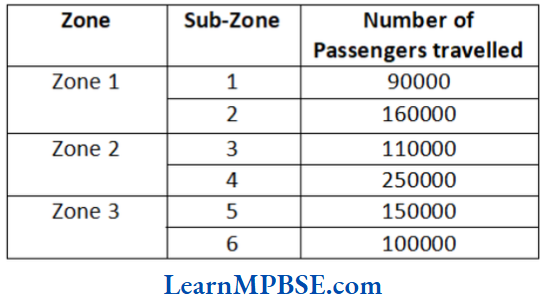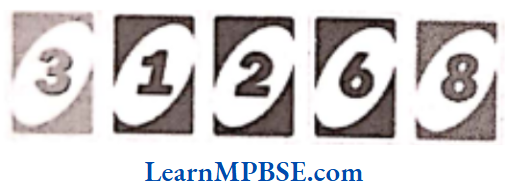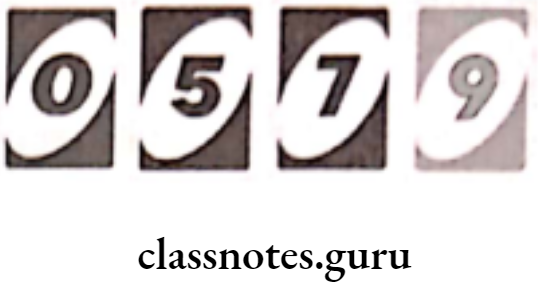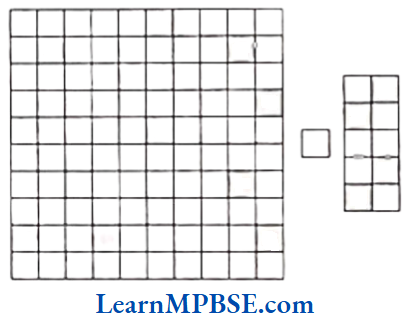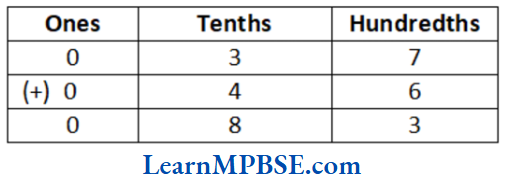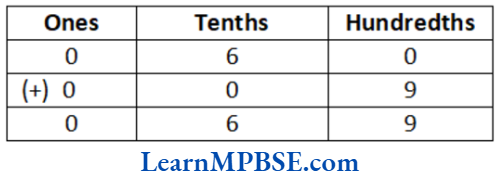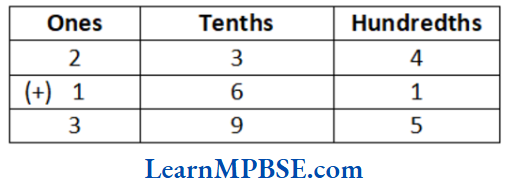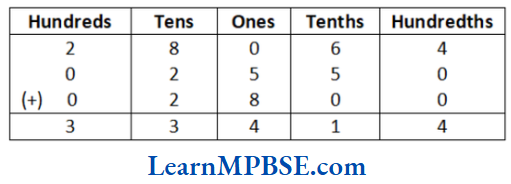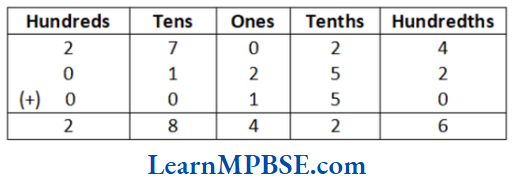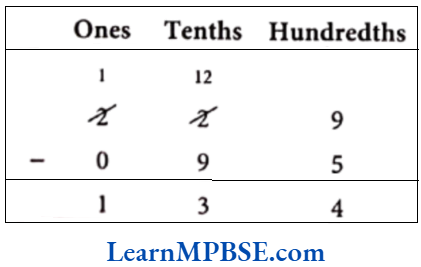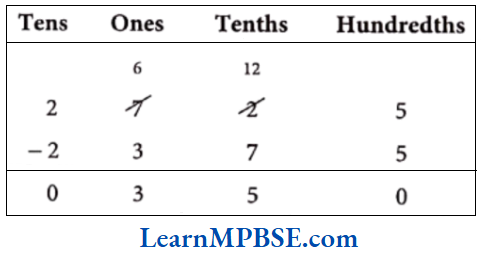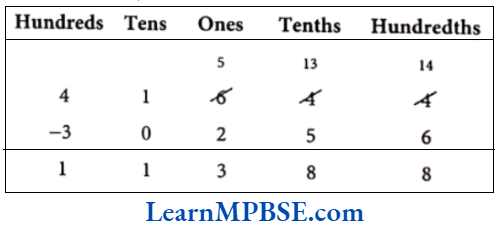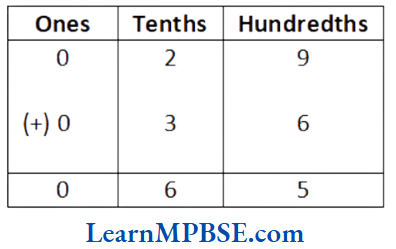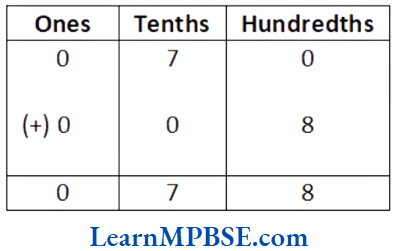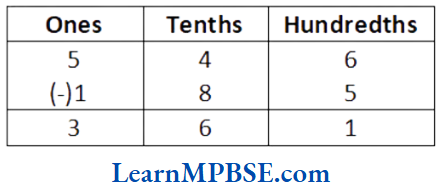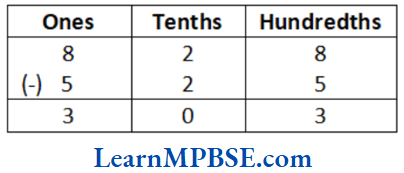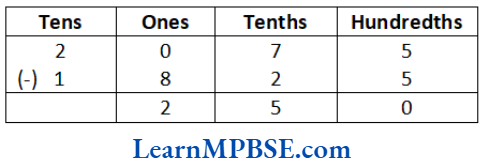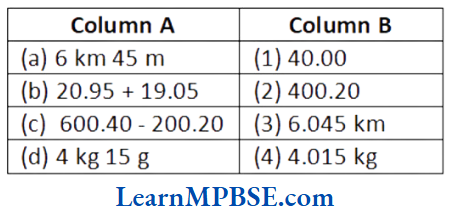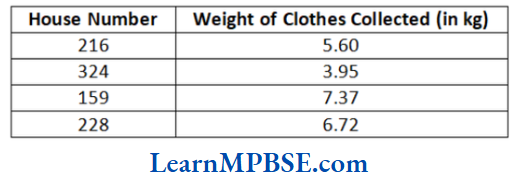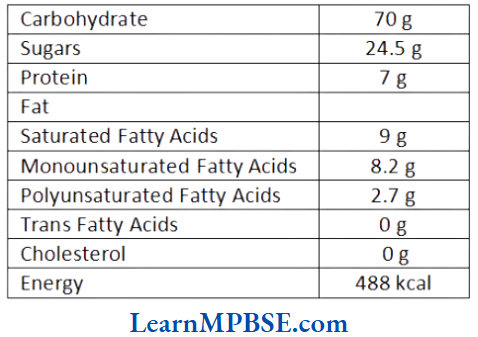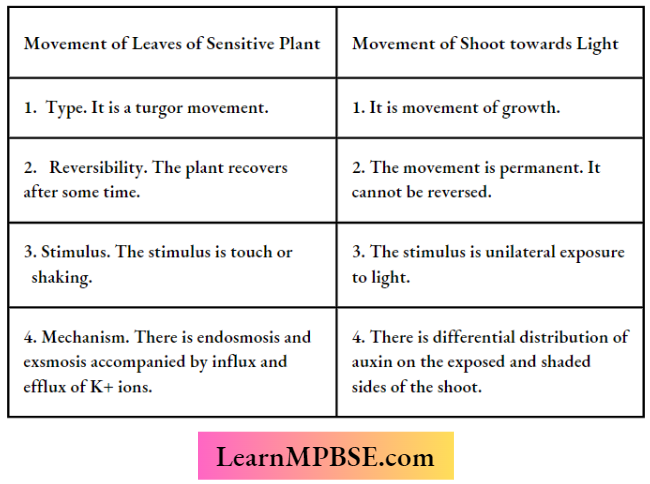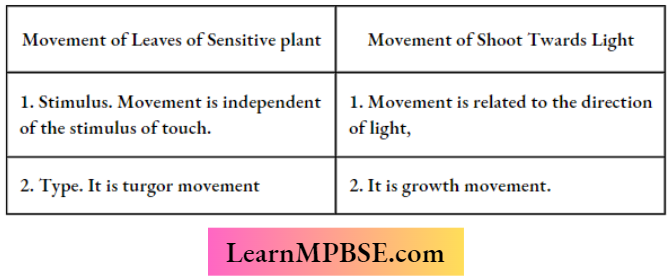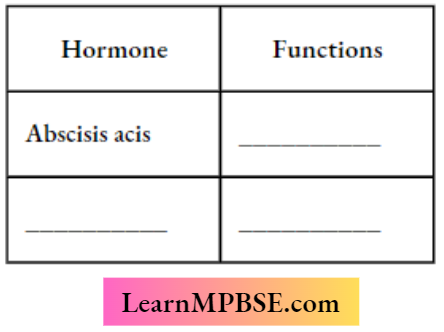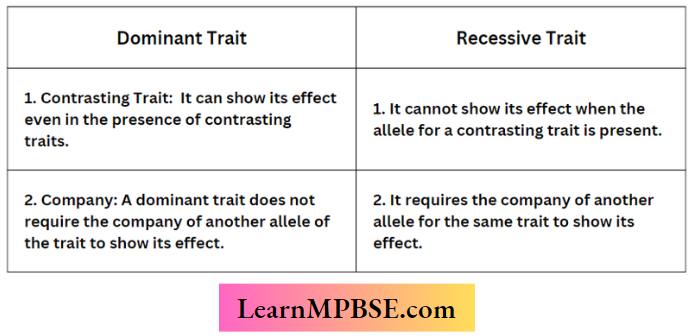MP Board Class 6 Maths Solutions For Chapter 5 Understanding Elementary Shapes
Line Segment
A line segment is a fixed portion of a line. This make it possible to measure a line segment. The distance between the end points of a line segment is called its length. We use the length to compare line segments.
To compare any two line segments, a relationship between their lengths is established.
1. Comparison by Observation
We can compare the line segments by just looking at them.
e.g.

Here, \(\overline{A B}>\overline{P Q}\)
Note it You cannot always be sure about your usual judgement.
2. Comparison by Tracing
In this method, we can compare the line segment using tracing paper. This method depends upon the accuracy in tracing the line segment. If you want to compare the length of a line segment with another line segment, you have to trace another line segment.
e.g.
![]()
To compare \(\overline{A B}\) and \(\overline{C D}\), trace CD and place the traced segment on \(\overline{A B}\). As a result, we get
\(\overline{A B}>\overline{C D}\)3. Comparison using Ruler and Divider Ruler and Divider
A graduated ruler and the divider are useful to compare lengths of line segments. One side of the ruler is divided into 15 parts.
Each of these 15 parts is of length 1 cm.. Each centimetre is divided into 10 subparts. Each subpart of the division of 1 cm is 10 mm.
MP Board Class 6 Maths Solutions
Read and Learn More MP Board Class 6 Maths Solutions
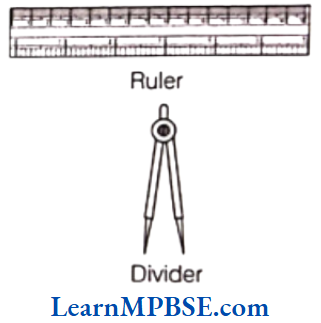
1 cm = 10 mm
Note it
1 mm = 0.1 cm, 2 mm = 0.2 cm
3.6 cm = 3 cm and 6 mm.
Use of Ruler to Measure Length
For comparison, place the 0 mark of the ruler at A. Read the mark against B. This gives the length of AB.
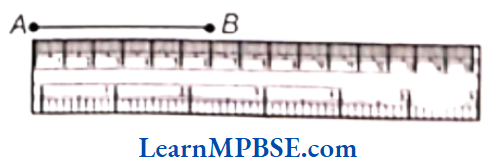
Suppose, the length of AB is 6 cm, we may write Length AB = 6 cm or more simply as \(\overline{A B}\) = 6 cm.
There are chances of errors even in this procedure.
Positioning Error
To get correct measure, the eye should be correctly positioned, just vertically above the mark. Otherwise, errors can happen due to angular viewing.
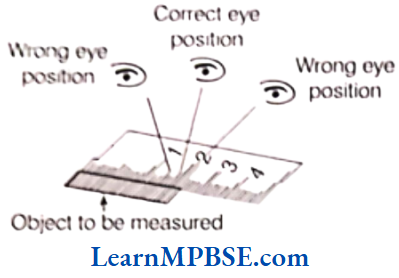
We can avoid this problem using divider.
Let us use the divider to measure length.
MP Board Class 6 Book Solutions
Use of Divider to Measure Length
Open the divider. Place the end point of one of its arms at A and the end point of the second arm at B. Taking care that opening of the divider is not disturbed, lift the divider and place it on the ruler. Ensure that one end point is at the zero mark of the ruler. Now, read the mark against the other end point.
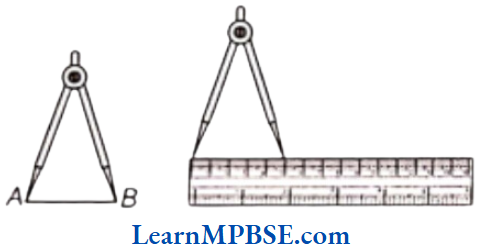
MP Board Class 6 Maths Solutions For Chapter 5 Understanding Elementary Shapes Right and Straight Angles
Angle
An angle is a figure formed by two rays with the same initial point. It is measured in degrees (°). The common initial point is also known as the vertex of the angle.
Revolution
Turning by a full rotation or a complete 360° angle in the same direction is called a revolution.

e.g. When hour or minute hand of a
clock moves from 12 to 12, it makes one revolution.
We can see such revolutions on clock-faces.
When the hand of a clock moves from one position to another, it turns through an angle.
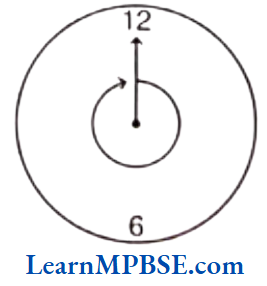
When the hand of a clock starts at 12 and reaches 3, it has reached quarter past and has made \(\frac{1}{4}\) of a revolution or 1 right angle which is equal to 90°.
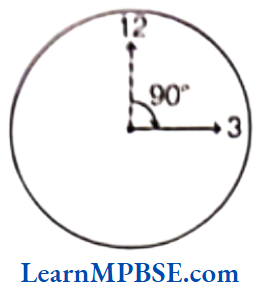
When the hand of a clock starts at 12 and reaches 6 1 (half past), the hand has made \(\frac{1}{2}\) of a revolution or 1 straight angle or 2 right angles which equals to 180°.

When the hand of a clock starts at 12 and reaches 9 (quarter to), the hand has made three quarter or \(\frac{3}{4}\) of a revolution or 3 right angles which equals to 270°.
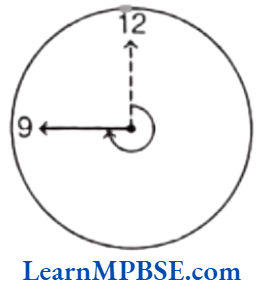
When the hand of a clock starts at 12 and reaches 12 again, it has moved exactly one round of the clock i.e. it has made one complete revolution and the angle for one revolution and the angle for one revolution is called complete angle or 2 straight angles or 4 right angles which equals t 360°.
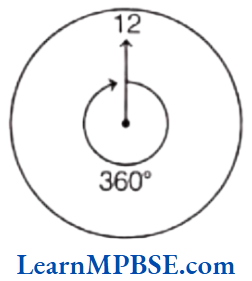
MP Board Class 6 Maths Solutions
Example 1. What fraction of a clockwise revolution does the hour hand of a clock turn through when it goes from
(1) 8 to 11
(2) 2 to 5
Solution. Moving of hour hand from 8 to 11 on clock is given in the figure.
Hence, from 8 to 11, hour hand turns through \(\frac{1}{4}\) of a revolution, clockwise.
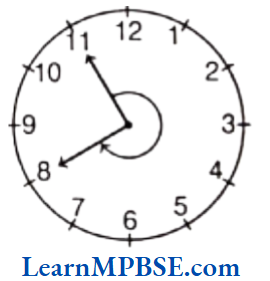
(2) Moving of hour hand from 2 to 5 on clock is given in the figure. Hence, from 2 to 5, hour hand turns through \(\frac{1}{4}\) of a revolution, clockwise.
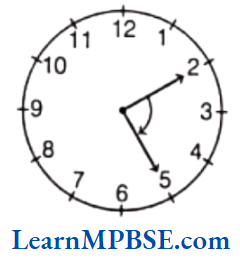
Example 2. Where will the hand of a clock stop, if it
(1) starts at 1 and makes \(\frac{1}{2}\) of a revolution, clockwise?
(2) starts at 4 and makes \(\frac{3}{4}\) of a revolution, clockwise?
(3) starts at 8 and makes \(\frac{1}{4}\) of a revolution, clockwise?
Solution. (1) If the hand of a clock starts at 1 and makes of a \(\frac{1}{2}\) revolution clockwise, it stops at 7.
(2) If the hand of a clock starts at 4 and makes \(\frac{3}{4}\) of a revolution, clockwise, it stops at 1.
(3) If hand of a clock starts at 8 and makes \(\frac{1}{4}\) of a revolution, clockwise, it stops at 11.
Class 6 Maths Chapter 5 Solutions
Example 3. Draw a rough diagram of the clock for each of the following
(1) One-fourth revolution
(2) Half revolution
(3) Three-fourth revolution
Solution.
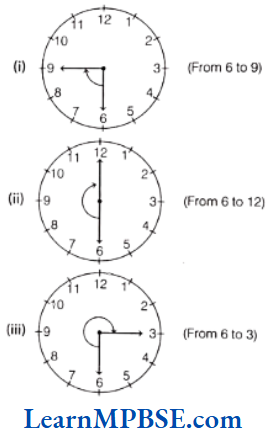
Example 4. How many right angles will hour hand of clock make in half revolution?
Solution. We know that 1 revolution = 4 right angles
Now, dividing by 2 on both sides, we get
\(\frac{1}{2}\) revolution = \(\frac{4}{2}\)right angles
∴ \(\frac{1}{2}\) revolution = 2 right angles
Example 5. Which direction will you face, if you start facing
(1) West and makes \(\frac{1}{2}\) of a revolution, clockwise?
(2) East and make \(\frac{3}{4}\) of revolution, anti-clockwise?
Solution. (1) If we start facing West and \(\frac{1}{2}\) make of a revolution clockwise i.e. two right angles, we will face East.
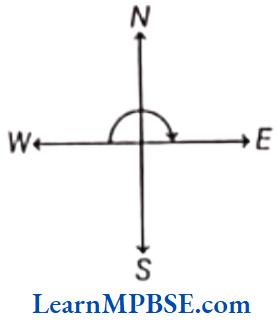
(2) If we start facing East and make \(\frac{3}{4}\) of revolution anti-clockwise i.e. three right angles, we will face south.
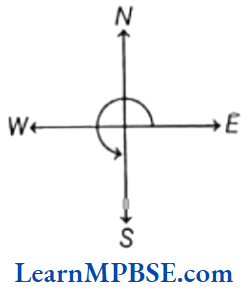
Example 6. Write the number of right angles turned through, by the hour hand of clock when it goes from
(1) 4 to 7
(2) 10 to 4
Solution.
(1) Here, the hour hand moves from 4 to 7. It starts from 4 and covers 5, 6 and 7. So, hour hand turned by one right angle.
(2) Here, the hour hand moves from 10 to 4. It starts from 10 and covers 11, 12, 1, 2, 3 and 4. So, hour hand turned by two right angles.
MP Board Class 6 Book Solutions
Example 7. How many right angles do you make, if you start facing
(1) East and turn clockwise to South?
(2) North and turn anti-clockwise to South?
(3) South and turn to South?
Solution.
(1) If we start turning clockwise from East to South, we make one right angle.
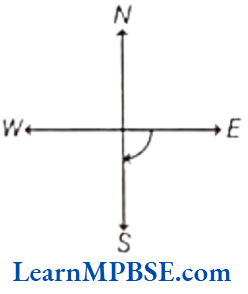
(2) If we start turning anti-clockwise from North to South we make two right angles.
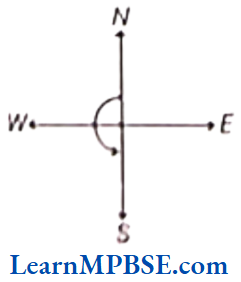
(3) If we start turning clockwise or anti-clockwise from South to South, we make four right angles.
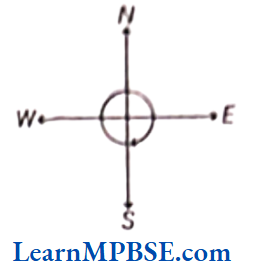
Example 8. Where will the hour hand of a clock stop, if it starts
(1) from 7 and turns through 1 right angle?
(2) from 9 and turns through 2 right angles?
(3) from 11 and turns through 3 right angles?
Solution.
(1) It is clear from the figure that the hour hand starts from 7 and turns through 1 right angle. Hence, it will reach at 10.
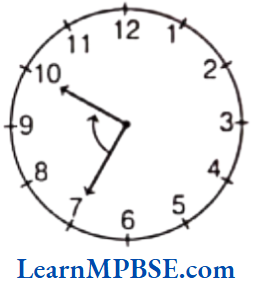
(2) It is clear from the figure that the hour hand starts from 9 and turns through 2 right angles. Hence, it will be at 3.
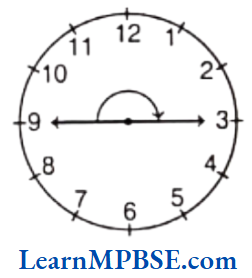
(3) It is clear from the figure that the hour hand starts from 11 and turns through 3 right angles. Hence, it will be at 8.

Example 9. If the hands of clock make one right angle. Then, show it by two different figure.
Solution. Two different figure are
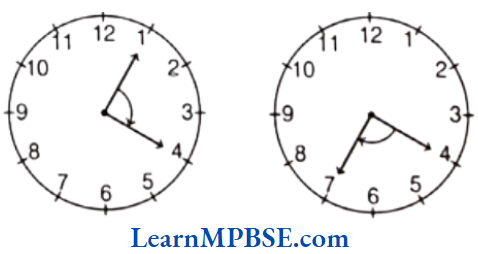
Class 6 Maths Chapter 5 Solutions
Example 10. If a clock hand makes three complete revolution, then how many right angles will be formed?
Solution. We know that there are four right angles in a complete revolution. Therefore, if a clock hand makes three revolution, then the number of right angles
= 3 x 4
= 12 right angles
Example 11. Find the number of straight angles turned by the hour hand of a clock when it goes from 3 to 9.
Solution. When hour hand goes from 3 to 9, it makes one straight angle.
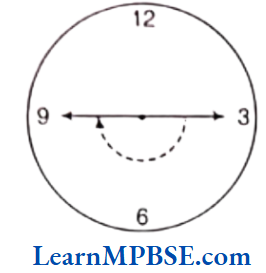
Example 12. Where will the hour hand of a clock stop if it starts
(1) from 6 and turns through 2 straight angles.
(2) from 9 and turns through 1 straight angle.
Solution. (1) It is clear from the figure that the hour hand starts from 6 and turns through 2 straight angles. Hence, it will be reach at 6 because 2 straight angles is equal to 4 right angles.
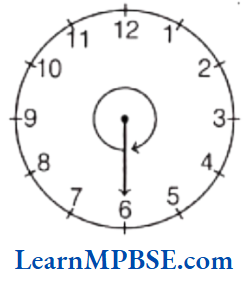
(2) It is clear from the figure that the hour hand starts from 9 and turns through 1 straight angle. Hence, it will reach at 3 because 1 straight angle is equal to 2 right angles.
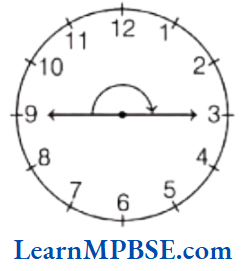
MP Board Class 6 Maths Solutions For Chapter 5 Understanding Elementary Shapes Acute, Obtuse and Reflex Angles
Acute Angle
An angle smaller than a right angle is called an acute angle or less than \(\frac{1}{4}\) of a revolution.
e.g. When hour hand moves from 12 to 2, it makes an acute angle.
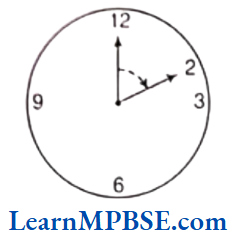
Class 6 Maths Chapter 5 Solutions
Example 1. How does the angle made by the hour hand of the clock look like when it moves from 6 to 8. Is the angle moved more than 1 right angle?
Solution. It looks like an acute angle.
We know that hour hand of a clock makes a right angle when it covers \(\frac{1}{4}\) of the revolution.
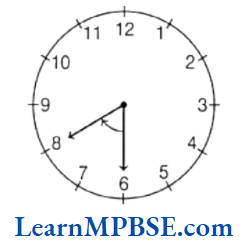
(∵ it covers 7, 8 and 9). Here, hour hand moves from 6 to 8 (covers only two numbers 7 and 8). So, that angle moved by hour hand is less than 1 right angle.
Obtuse Angle
An angle larger than a right angle but less than straight angle is called an obtuse angle.
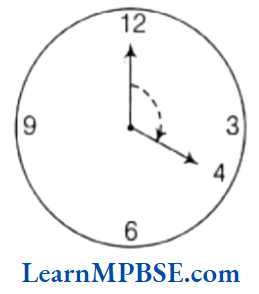
e.g. When hour hand moves from 12 to 4, it makes an obtuse angle.
Example 2. The hour hand of a clock moves from 3 to 7. Is the revolution of the hour hand more than 1 right angle?
Solution. Yes, it is clear from the figure that hour hand makes one right angle from 3 to 6. So, revolution of the hour hand is more than 1 right angle. It looks like an obtuse angle.
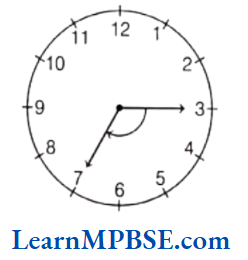
Class 6 Maths Chapter 5 Solutions
Example 3. If a boy facing East and makes \(\frac{1}{4}\) revolution clockwise. Further makes \(\frac{1}{6}\)revolution clockwise. Then, name the angle that he turned totally?
Solution. When boy makes \(\frac{1}{4}\) revolution clockwise.
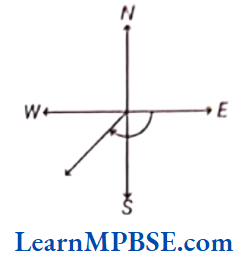
He makes a right angle. Then, he further makes revolution \(\frac{1}{6}\) which is greater than right angle and smaller than straight angle. Therefore, the angle he made is obtuse angle.
Reflex Angle
An angle larger than the straight angle but less than complete angle is called reflex angle.
e.g. When hour hand moves from 12 to 7, it makes a reflex angle.
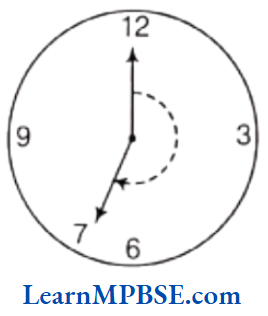
Understanding Elementary Shapes Class 6
Example 4. The hour hand of a clock moves from 3 to 10. Is the revolution of the hour hand more than 2 right angle?
Solution. Yes, it is clear from the figure that hour hand makes 2 right angles from 3 to 9. So, the revolution of the hour hand is more than 2 right angle. It look like a reflex angle.
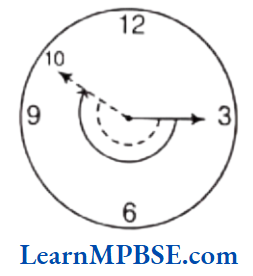
Chapter 5 Understanding Elementary Shapes Measuring Angles
One complete revolution is divided into 360 equal parts. Each part is of one degree (i.e.1°) and we can write one complete revolution as 360° to say ‘three hundred sixty degrees.
Thus, in a clock, 12 divisions = 360°.
To find the measure of an angle, we use an instrument named as protractor.
The Protractor
You can find a protractor in your ‘instrument box’. The curved edge of protractor is divided into 180 equal parts. Each part is equal to one degree.
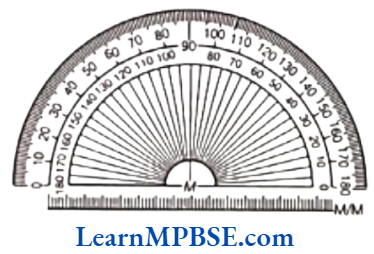
The markings start from 0° on the right side and ends with 180° on the left side and vice-versa.
Steps of Measuring an Angle
Suppose you want to measure an ZABC, follow the steps given below.
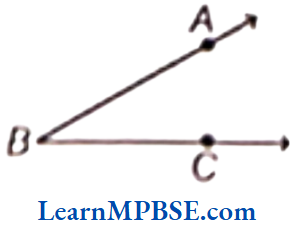
Step 1. Place the protractor, so that the mid-point (M in the figure) of its straight edge lies on the vertex B of the ∠ABC
Step 2. Adjust the protractor, so that ray BC is along the straight-edge of the protractor.
Step 3. There are two ‘scales’ on the protractor, read that scale which has the 0° mark coinciding with the straight-edge (i.e. with ray BC).
Step 4. The mark shown by ray BA on the curved edge gives the degree measure of the angle.
We write m ∠ABC = 40° or simply ∠ABC = 40°.
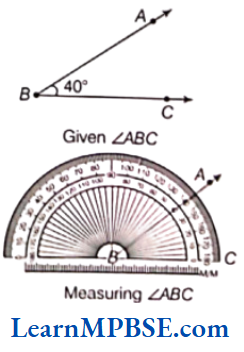
Understanding Elementary Shapes Class 6
Example 1. Measure the angles given below using the protractor and write down the measure.
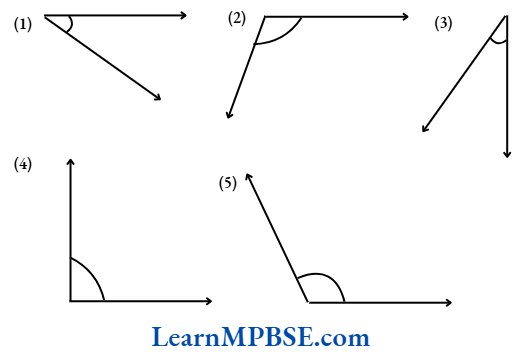
Solution. On measuring the given angles using protractor, we find that
(1) The measure of the given angle is 20°.
(2) The measure of the given angle is 110°.
(3) The measure of the given angle is 45°.
(4) The measure of the given angle is 90°.
(5) The measure of the given angle is 135°.
Example 2. Compare the given angles by their measurement.
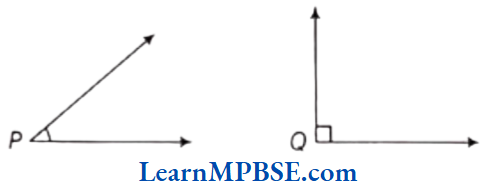
Solution. The measurement of ∠P = 30°
The measurement of ∠Q = 90°,
Hence, ∠Q > ∠P
Example 3. Write down the measure of
(1) some acute angles
(2) some obtuse angles
(give atleast two examples of each)
Solution. We know that the measure of an acute angle is always less than 90°. So, 89°,77°,75°, 60°, 40° all are acute angles.
Also, we know that the measure of an obtuse angle is always greater than 90°. So, 95°, 122°, 111° all are obtuse angles.
Example 4. Which angle has a larger measure?
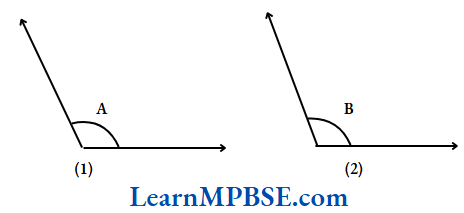
First estimate and then measure ∠A and ∠B
Solution. Observing the given angles, we find that ∠A > ∠B
Measure of ∠A = 120°, Measure of ∠B = 100°
Understanding Elementary Shapes Class 6
Example 5. From these two angles which has larger measure? Estimate and then confirm by measuring them.
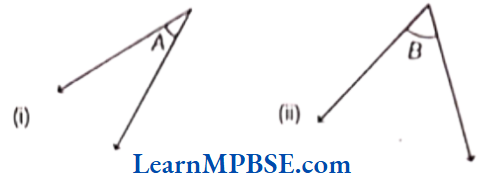
Solution. On observing, we find that ∠B > ∠A.
On measuring, we find that ∠A = 30° and ∠B = 60° Thus, ∠B > ∠A
Example 6. Find the measure of the angle shown in each figure. (First estimate with your eyes and then find the actual measure with a protractor)

Solution. On estimating with eyes, the measure of angle shown in figure are as follows
(1) 30°
(2) 130°
(3) 80°
Now, on measuring with the protractor, measure of angle shown in figure are as follows:
(1) 35°
(2) 135°
(3) 75°
MP Board Class 6 Chapter 5 Maths
Example 7. Find the angle measure between the hands of the clock in each figure.

Solution.
(1) Number of divisions between 12 to 3 = 3
We know that 12 divisions = 360°
\(1 \text { division }=\frac{360^{\circ}}{12}\)∴ \(3 \text { divisions }=\frac{360^{\circ}}{12} \times 3=90^{\circ}\)
Hence, the angle between the hands of clock is 90°.
(2) Number of divisions between 9 to 3=6
We know that 12 divisions = 360°
\(1 \text { division }=\frac{360^{\circ}}{12}\)∴ \(6 \text { divisions }=\frac{360^{\circ}}{12} \times 6=180^{\circ}\)
Hence, the angle between the hands of clock 180°.
MP Board Class 6 Maths Solutions For Chapter 5 Understanding Elementary Shapes Perpendicular Lines
If two lines intersect each other and the angle between them is a right angle, then these lines are said to be perpendicular lines.
e.g. In the following figure, line AB is perpendicular to line CD i.e. AB ⊥ CD
and point O is the point of intersection of line segments AB and CD.
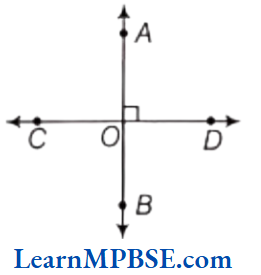
Example 1. Which of the following are models for perpendicular lines?
(1) The opposite edge of a ruler.
(2) The letter Z
(3) Railway lines
(4) The letter L
Solution. (1) No, the opposite edges of a ruler does not make a model of perpendicular lines.
(2) No, the letter Z does not make a model of perpendicular lines.
(3) No, railway lines does not make a model of perpendicular lines.
(4) Yes, the letter L does make a model of perpendicular lines.
MP Board Class 6 Chapter 5 Maths
Example 2. Consider a line AB is perpendicular to the line XY. If AB and XY intersect at the point Q, then find the measure of ∠AOY.
Solution. Given, AB is perpendicular to XY and AB and XY both intersect each other at the point O.
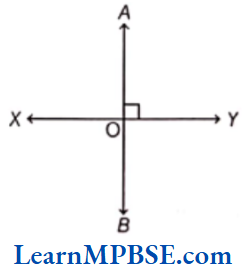
So, it is clear from the adjoining figure that ∠AOY = 90°
Example 3. Find the angle Indicated below and write name of lines which are perpendicular to each other.
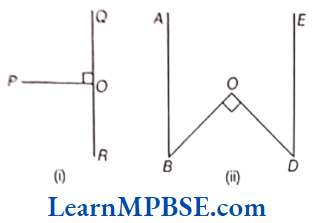
Solution. (1) ∠POQ = 90° and PO ⊥ QR
(2) ∠BOD = 90° and BO ⊥ OD
Perpendicular Bisector
The perpendicular bisector of a line segment is perpendicular to the line segment that divide it into two equal parts.
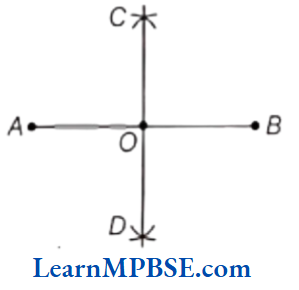
e.g. In the given figure, CD is perpendicular bisector to line segment AB.
MP Board Class 6 Chapter 5 Maths
Example 4. Study the following diagram. The line / and line mare perpendicular to each others.
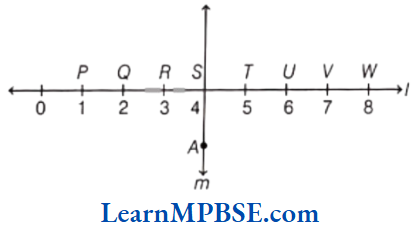
(1) Is RS = ST?
(2) Does AS bisect PV?
(3) Identify any two lines segments for which AS is the perpendicular bisector.
(4) Are these true?
(a) PR > TU
(b) QR = UV
(c) PQ < TW
Solution.
(1) From the given figure,
RS = 1 unit
ST = 1 unit
∴ RS = ST = 1 unit
(2) PS = 3 units
SV = 3 units
∴ PS = SV = 3 units
Now, PS = SV
So, S is the mid-point of PV.
Thus, AS bisects PV.
(3) In the given figure, we can see that AS is the perpendicular to the given line segment.
Since, RS = ST [each = 1 unit]
So, AS is the perpendicular bisector of RT.
Again, QS = SU [each 2 unit]
So, AS is the perpendicular bisector of QU.
(4) (a) Here, PR = PQ + QR
= 1 + 1 = 2 units[PQ = QR = 1 unit]
and TU = 1 unit
∴ PR > TU is true.
(b) Here, QR = 1 unit and UV = 1 unit.
∴ QR = UV = 1 unit
∴ QR = UV is true.
(c) Here, PQ = 1 unit and TW = 3 unit
∴ PQ < TW is true.
Example 5. List out English alphabets which are examples of perpendicular. Write, if any.
Solution. Letter F, L and T are examples of perpendicular lines segments.
Example 6. Observe the following figure, if the line segments PQ and RS are perpendicular bisector of each other and PQ = 6 cm and RS = 8 cm, then find PO and OR?
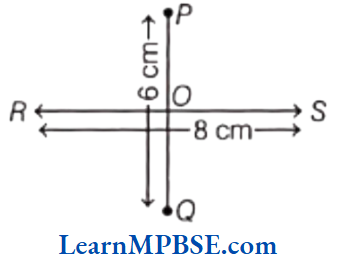
Solution. Since, PQ and RS are perpendicular bisector to each other, therefore they divide each other equally.
Now, PQ = 6 cm
∴ PO + OQ = 6 cm
PO = 3cm
and RS = 8 cm
∴ RO = \(\frac{8}{2}\) = 4 cm
Hence, PO = 3 cm
and RO = 4 cm
MP Board Class 6 Maths Solutions For Chapter 5 Understanding Elementary Shapes Triangles
A polygon with least number of sides is called a triangle or we can say a plane figure bounded by three lines is called triangle.
Classification Based on Length of the Sides
A triangle is classified according to the measurement of its sides as given below
1. Scalene Triangle
A triangle having all three unequal sides is called a scalene triangle. e.g. ΔABC is a scalene triangle where, AB ≠ BC ≠ CA
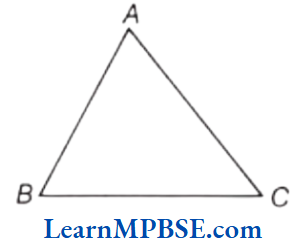
2. Isosceles Triangle
A triangle having two equal sides is called an isosceles triangle.
e.g. ΔABC is an isosceles triangle where, AB = AC
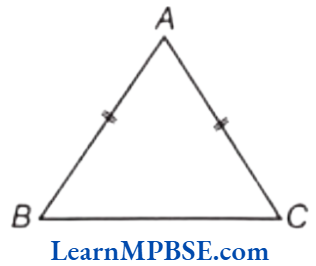
3. Equilateral Triangle
A triangle having three equal sides is called an equilateral triangle.
e.g. ΔABC is an equilateral triangle. where, AB = BC = CA
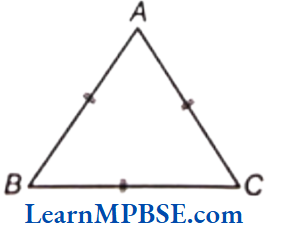
MP Board Class 6 Chapter 5 Maths
Example 1. Name the triangle with lengths of sides
(1) 9 cm, 10 cm and 11 cm.
(2) 7 cm, 7 cm and 9 cm.
(3) ΔPQR such that PQ = QR = PR = 6 cm.
Solution. (1) Given, first side = 9 cm, second side = 10 cm, and third side = 11 cm
i.e. all the sides are of different length.
So, it is a scalene triangle.
(2) Given, first side = 7 cm, second side = 7 cm and third side = 9 cm
i.e. two sides are equal. So, it is an isosceles triangle.
(3) Given, PQ = QR = PR = 6 cm
i.e. all sides of triangle are equal.
So, it is an equilateral triangle.
Classification Based on Measurement of Angles
A triangle is further classified according to the measurement of its angles as given below
1. Acute Angled Triangle
If each angle of a triangle is less than 90°, then the triangle is called an acute angled triangle.
e.g. ΔPQR is an acute angled triangle where, ∠P, ∠Q and ∠R are acute angles i.e. less than 90°.
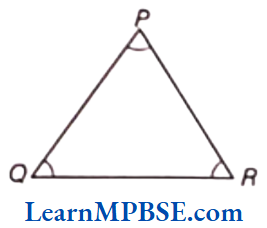
2. Right Angled Triangle
If any one angle of a triangle is a right angle, then the triangle is called a right angled triangle.
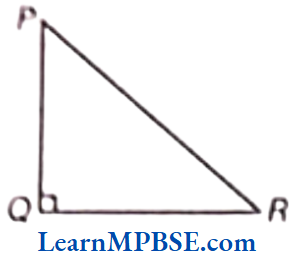
e.g. ΔPQR is a right angled triangle where, ∠Q = 90°.
3. Obtuse Angled Triangle
If any one angle of a triangle is greater than 90° but less than 180°, then the triangle is called an obtuse angled triangle.
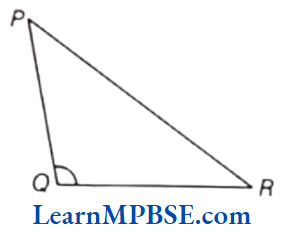
e.g. ΔPQR is an obtuse angled triangle, where ∠Q > 90°.
MP Board Class 6 Chapter 5 Maths
Important Properties of Triangles
1. If three sides of a triangle are equal, then the three angles are also equal. Its vice-versa is also true.
2. If two sides of a triangle are equal, then it has two equal angles. Its vice-versa is also true.
3. If three sides of a triangle are unequal, then the three angles are also unequal.
Example 2. Classify the triangles given below.
(1) ΔPQR, m∠P = 40°, m∠Q = 75° and m∠R = 65°.
(2) ΔABC m∠B = 90°.
(3) ΔLMN, m∠M = 90° and LM = MN.
Solution. (1) Given, m∠P = 40°, m∠Q = 75° and m∠R = 65°
Since, all the angles are different and less than 90°. So, it is an acute angled triangle.
(2) Given, m∠B = 90°
i.e. measure of ∠B = 90°.
So, it is a right angled triangle.
(3) Given, m∠M = 90°
i.e. measure of ∠M = 90° and LM = MN
Here, one angle is right angle and two sides are equal.
So, it is an isosceles right angled triangle.
Example 3. In a ΔABC, ∠A = ∠B = ∠C = 60°, then what can you say about the length of sides of ΔABC? Also, write the name of the triangle.
Solution. It is the property of triangle that if all the angles of a triangle are equal, then the three sides of a triangle are also equal.
Thus, the given triangle is an equilateral triangle.
Example 4. In a ΔXYZ, XY = XZ and ZY = 65°. Then, find the value of ∠Z.
Solution. Since, the XY = XZ i.e. two sides of a triangle are equal, therefore it is an isosceles triangle.
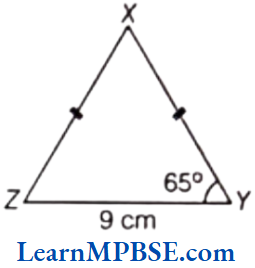
So, ∠Y = ∠Z
∴ ∠Z = 65°
Example 5. Name each of the following triangles in two different ways. (You may judge the nature of the angle by observation)
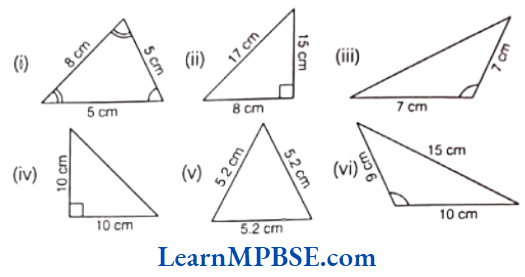
Solution.
- Here, two sides are equal, so it is an isosceles triangle and all the angles are acute angles. So, it is an acute angled triangle also.
- In the given figure, all sides are different, so it is a scalene triangle and one angle is right angle. So, it is an right angled triangle also.
- Here, two sides are equal, so it is an isosceles triangles and one angle is an obtuse angle. So, it is an obtuse angled triangle also.
- In the given figure, two sides are equal, so it is an isosceles triangle and one angle is right angle. So, it is a right angled triangle also.
- Here, all the sides are equal, so it is an equilateral triangle and all the angles are acute. So, it is an acute angled triangle also.
- In the given figure, all the sides are different, so it is a scalene triangle and one angle is an obtuse angle. So, it is an obtuse angled triangle also.
MP Board Class 6 Maths Solutions For Chapter 5 Understanding Elementary Shapes Quadrilaterals
A quadrilateral is a polygon which has four sides, four angles and two diagonals.
Classification of Quadrilaterals
Quadrilaterals can be classified as given below
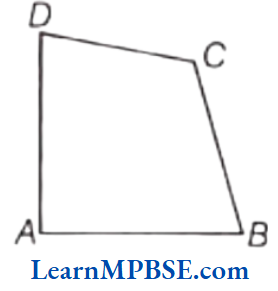
1. Rectangle
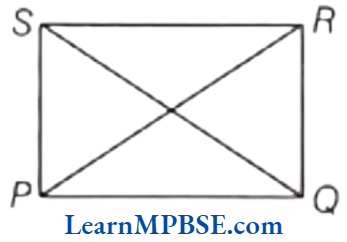
(1) PQ = SR,
PQ || SR
SP = RQ,SP || RQ
(2) ∠P = ∠Q = ∠R = ∠S = 90°
(3) SQ = PR
2. Square

(1) PQ || SR and SP || QR
and PQ = QR = RS = SP
(2) ∠P = ∠Q = ∠R = ∠S = 90°
(3) PR = SQ
3. Parallelogram
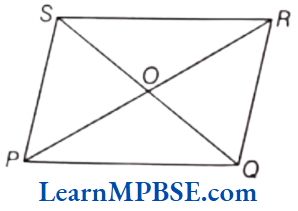
(1) PQ = SR, PQ || SR, SP = QR, SP || QR
(2) ∠P = ∠R, and ∠S = ∠Q
(3) PR ≠ SQ (some times PR=SQ) and OS = OQ, and OR = OP
4. Rhombus
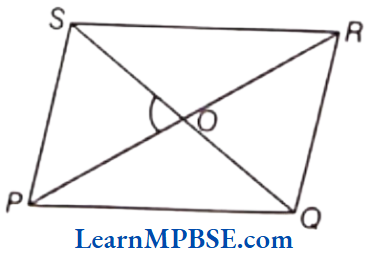
(1) PQ || SR and PS || QR
PQ = QR = RS = SP
(2) ∠P = ∠R and ∠S = ∠Q
(3) PR ≠ SQ (sometimes it may be equal) and
OP = OR, OS = OQ
5. Trapezium
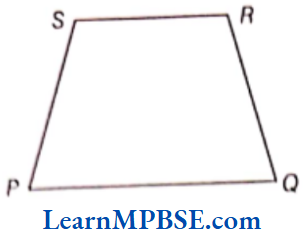
(1) SR || PQ
(2) SR ≠ PQ and SP ≠ RQ
A trapezium is said to be an isosceles trapezium, if its non-parallel sides are equal i.c. SP = RQ
Example 1. Write the number of pairs of opposite sides which are parallel?
Solution. In the adjoining figure, a parallelogram is given.
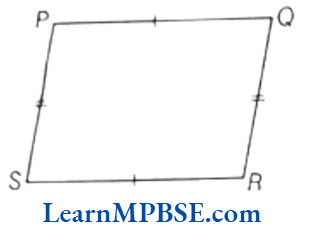
Here, PQ || SR and PS || QR
Therefore, the number of pairs of opposite sides which are parallel is 2.
MP Board Class 6 Chapter 5 Maths
Example 2. In the given figure PQRS is a quadrilateral, if PR ⊥ SQ, then name all the right angles.
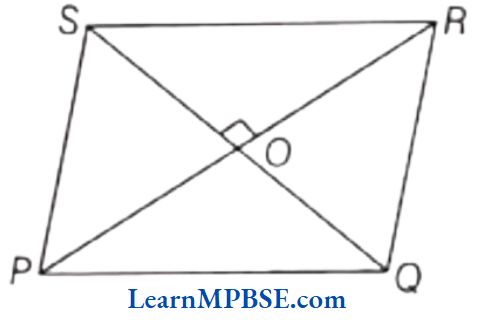
Solution. The right angles in the given figure are ∠POQ, ∠QOR, ∠ROS, ∠SOP.
Example 3. In the adjoining figure, a rectangle is given. Write how many right angles are there.

Solution. According to the property of a rectangle, all the interior angles of a rectangle are right angle (i.e. 90°).
∴ There are four right angles in a rectangle.
Example 4. What is a regular quadrilateral? Draw its figure.
Solution. We know that a square has all its sides and angles equal, so it is said to be a regular quadrilateral
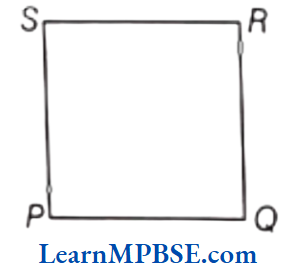
where, PQ = QR = RS = SP
and ∠P = ∠Q = ∠R = ∠S = 90°
Example 5. State the condition under which a rectangle is considered a square.
Solution. A rectangle will be considered as a square if all the sides of a rectangle are equal.
Example 6. Fill in the blanks
(1) The opposite sides of a rectangle are ……. in length.
(2) The diagonals of a square are ……. to one another.
(3) the opposite sides of a trapezium are ……
(4) Each angle of a rectangle is a ……
Solution. (1) equal
(2) perpendicular
(3) parallel
(4) right angle
Example 7. State the reason for the following, if it is true.
(1) A square is the special case of the rectangle.
(2) Parallelogram is a special case of the rectangle.
Solution. (1) Yes, its true. In square, opposite sides are equal and all angles are right angles, so a square is a special case of rectangle.
(2) No, it is not true.
MP Board Class 6 Chapter 5 Maths
Example 8. Write the name of the quadrilaterals in which diagonals are perpendicular to each other?
Solution. In square and rhombus, diagonals are perpendicular to each other.
MP Board Class 6 Maths Solutions For Chapter 5 Understanding Elementary Shapes Polygons
Polygon is a closed shape made of line segments only.
Polygons are classified according to the number of their
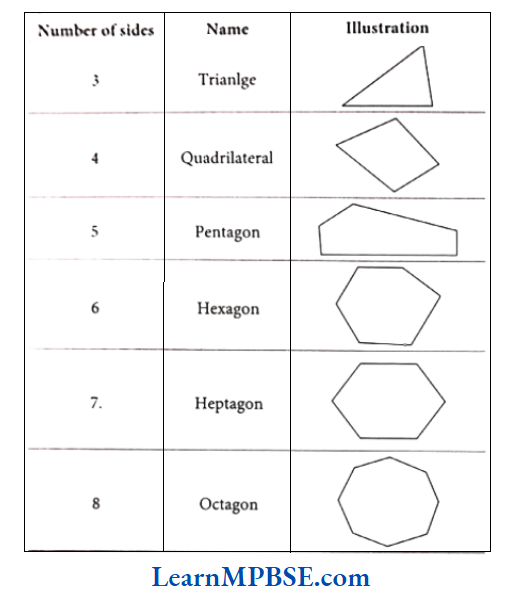
These shapes can be seen in everyday life. Windows, doors, walls, almirahs, blackboards, notebooks etc. are usually rectangular in shapes.
Note It
(1) If a polygon has all equal sides, then it is said to be a regular polygon.
(2) The angle determined by two sides meeting at a vertex is called an angle of the polygon.
Example 1. Examine whether the following are polygons. If any one among them is not, say why?
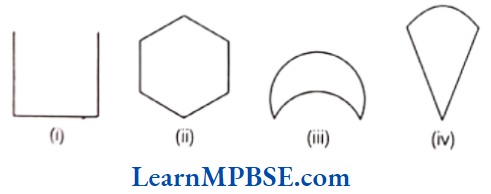
Solution. (1) It is an open figure. So, it is not a polygon.
(2) It is closed figure. So, it is a polygon with six sides i.e. hexagon.
(3) It is not made by line segments. So, it is not a polygon.
(4) It is made by two line segments and curved line. So, it is not a polygon.
Example 2. Name each polygon. Make one more example of each of these.

Solution. (1) This polygon has four sides, so it is quadrilateral. e.g.
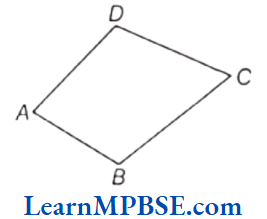
(2) This polygon has three sides, so it is a triangle. e.g.
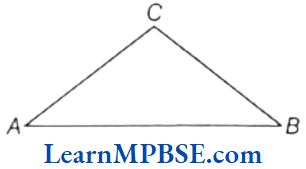
(3) This polygon has five sides, so it is pentagon. e.g.

Example 3. Can you draw an equilateral triangle inside a regular hexagon. Show.
Solution. Consider, a regular hexagon ABCDEF.
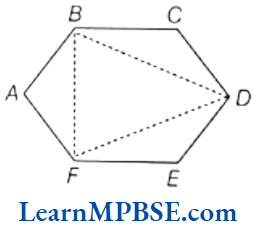
Joining its alternate vertices B, D and F, we get ABDF, which is a regular triangle, (since, all sides are equal).
Thus, the triangle, so formed is an equilateral triangle.
Example 4. Can you make any two rectangle inside a regular octagon. Show.
Solution. Consider, PQRSTUVW is a regular octagon.
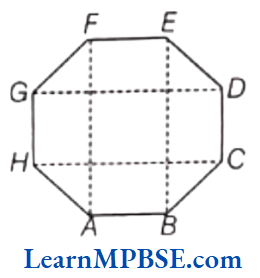
Join vertices P and U, we get \(\overline{P U}\).
Join Q and T, we get \(\overline{Q T}\). Thus, we get a rectangle PQTU.
Again, by joining W, Rand V, S we can get another rectangle WRSV.
Class 6 Maths Chapter 5 Solutions MP Board
Example 5. A diagonal is a line segment that joins any two vertices of the polygon and is not a side of the polygon. Draw
(1) pentagon and its diagonals
(2) hexagon and its diagonals
Solution. (1) Here, PQRST is a pentagon.
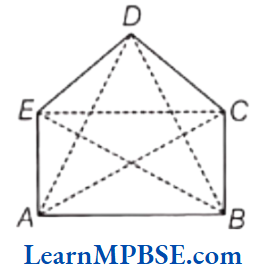
By joining any two vertices, we get diagonals as \(\overline{T R}, \overline{T Q}, \overline{P R}, \overline{P S} \text { and } \overline{S Q} \text {. }\)
(2) Here, ABCDEF is a hexagon
By joining any two vertices, we get diagonals as \(\overline{A D}, \overline{A C}, \overline{A E}, \overline{B F}, \overline{B E}, \overline{F C}, \overline{E C}, \overline{B D}, \overline{F D} .\)
Example 6. What is the condition for a polygon to be considered as a regular polygon? Give any two examples of it.
Solution. When all sides of the polygon are equal in length, the polygon is considered as regular polygon.
e.g. (1) An equilateral triangle
(2) A square
Example 7. Write the number of sides and name of the following figure.

Solution. (1) It is a triangle. The number of sides is 3.
(2) It is a heptagon.
The number of sides is 7.
(3) It is a quadrilateral.
The number of sides is 4.
Example 8. Given a regular pentagon PQRST, where QR = 3 cm, then find the value of x.
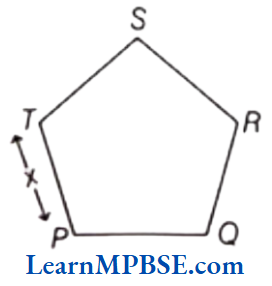
Solution. Since, QR = 3cm
∴ x = PT = 3cm
because in a regular pentagon, all sides are equal.
MP Board Class 6 Maths Solutions For Chapter 5 Understanding Elementary Shapes Exercise 5.1
Question 1. What is the disadvantage in comparing line segments by mere observation?
Solution.
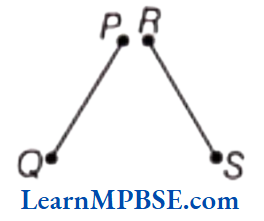
The disadvantage in comparing line segments by mere observation is that sometimes the difference in lengths between Q two line segments may not accurate. So, we cannot always be sure about our usual judgement. e.g. In the given figure, the line segments \(\overline{P Q}\) and \(\overline{R S}\) seems to be equal but actually they are not equal.
Question 2. Why is it better to use a divider than a ruler, while measuring the length of a line segment?
Solution. When we measure the length of a line segment by ruler, there may be some errors due to its thickness and angular viewing. These errors can be removed by measuring a line segment with the help of a divider. Hence, the use of a divider is better than a ruler.
Question 3. Draw any line segment, say \(\overline{A B}\) Take any point Clying in between A and B Measure the lengths of AB, BC and AC. Is AB = AC + CB?
Solution. Let AB be the line segment of length 6 cm and point C lying between A and B.

On measuring the lengths of line segments AB, AC and CB using ruler, we find that AB = 6 cm, AC = 4 cm and CB = 2 cm
Now, AC + CB = 4 + 2 = 6 cm = AB
i.e. AC + CB = AB
So, we can say that C lies between A and B.
Note If A. B and C are any three points on a line such that AC + CB = AB, then point C will lie between points A and B. Its converse is also true.
Class 6 Maths Chapter 5 Solutions MP Board
Question 4. If A, B amd C are three points on a line such that AB = 5 cm, BC = 3 cm and AC = 8 cm, which one of them lies between the other two?
Solution. Firstly, draw a line AV of 8 cm. Take a point B on AC such that AB = 5 cm.
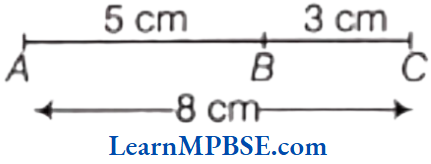
Now, length of BC = AC – AB = 8 – 5 = 3cm
Thus, AB + BC = AC
So, the point B lies between point A and C.
Question 5. Verify whether Dis the mid-point of \(\overline{A G}\).
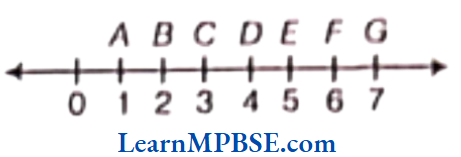
Solution. From the given figure, it is clear that
AD = AB + BC + CD = 1 + 1 + 1 = 3 units
and DG = DE + EF + FG = 1 + 1 + 1 = 3 units Now,
AG = AD + DG = 3 + 3 = 6 units
and AD = DG 3 units
∴ D lies between A and G.
∴ D is the mid-point of AG.
Question 6. If Bis the mid-point of \(\overline{A C}\) and C is the mid-point of \(\overline{B D}\), where A, B, Cand Dlie on a straight line, say why AB = CD?
Solution. Given, B is the mid-point of \(\overline{A C}\).
∴ AB = BC …(1)
and C is the mid-point of \(\overline{B D}\).
∴ BC = CD …(2)
i.e.

Now, on adding Eqs. (1) and (2), we get
AB + BC = BC + CD
AB = CD
Hence proved
Question 7. Draw five triangles and measure their sides. Check in each case, if the sum of the lengths of any two sides is always less than the third side.
Solution.
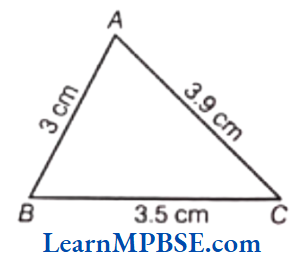
(1) Here, we draw a ΔABC
in which AB = 3 cm,
BC = 35 cm and AC = 39 cm
Now, by adding two sides of ΔABC
i.e. AB + BC = 3 + 3.5 = 6.5 cm Clearly,
AB + BC > AC
(2) Here, we draw a ΔABC in which AB = 3cm, BC = 4 cm and AC = 5 cm
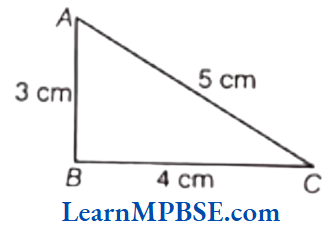
Now, by adding two sides of ΔABC
i.e. AB + BC = 3 + 4 = 7cm
Clearly, AB + BC > AC
(3) Here, we draw a ΔABC in which
AB = BC = AC = 25 cm
Now, by adding two sides of ΔABC
i.e. AB + BC = 2.5 + 2.5 = 5cm
Clearly, AB + BC > AC
(4) Here, we draw a ΔABC in which
AB = 3cm, BC = 35 cm and AC = 4 cm
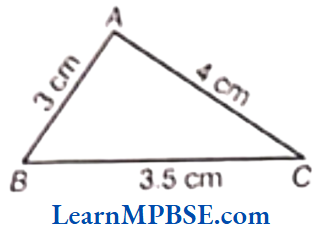
Now, by adding two sides of ΔABC
i.e. AB + BC = 3 + 3.5 = 6.5 cm
Clearly, AB + BC > AC
(5) Here, we draw a ΔABC in which
AB = 2 cm, BC = 4 cm and AC = 45 cm

Now, by adding two sides of ΔABC
i.e. AB + BC = 2 + 4 = 6 cm
Clearly, AB + BC > AC
From all these triangles, we observe that in each case, the sum of the lengths of any two sides is greater tahn the third side. So, the sum of the lengths of any two sides can never be less than the third side.
MP Board Class 6 Maths solutions
Question 8. What is the angle name for half a revolution?
Solution. We know that 1 revolution = 2 straight angles
Now, dividing by 2 both sides, we get
\(\frac{1}{4}\) revolution = \(\frac{2}{2}\) straight angle = 1 straight angle
Hence, the angle name for half a revolution is straight angle or two right angles.
Question 9. What is the angle name for one-fourth revolution?
Solution. We know that I revolution = 4 right angles
Now, dividing by 4 on both sides, we get
\(\frac{1}{4}\) revolution = \(\frac{4}{4}\) right angles
\(\frac{1}{4}\) revolution = 1 right angle
Hence, the angle name for one-fourth revolution is one right angle.
Question 10. Draw five other situations of one-fourth, half and three-fourth revolution on a clock.
Solution. (1) One-fourth revolution For one-fourth revolution, the clock hand moves in many individual routes. Some of these situations on a clock are as follows:
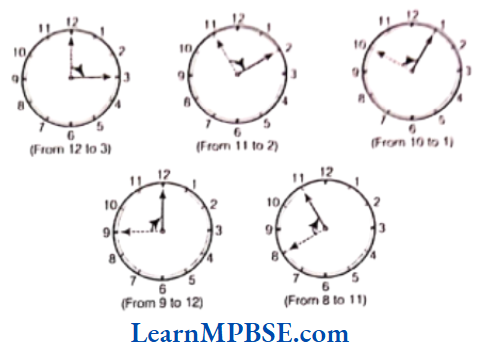
(2) Half revolution For half revolution, the clock hand moves in many individual routes. Some of these situations on a clock are as follows
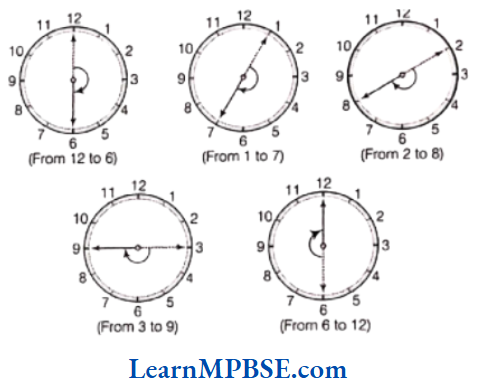
(3) Three-fourth revolution For three-fourth revolution, the clock hand moves in many individual routes. Some of these situations on a clock are as follows:
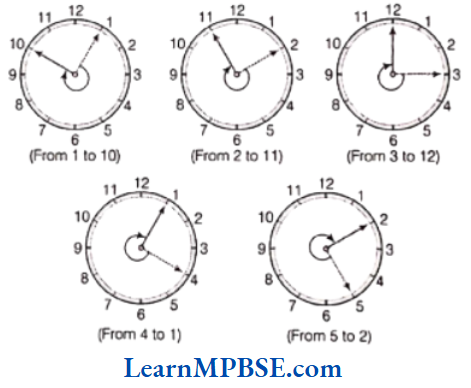
MP Board Class 6 Maths Solutions For Chapter 5 Understanding Elementary Shapes Exercise 5.2
Question 1. What part of a revolution have you turned through, if you stand facing
(1) East and turn clockwise to face North?
(2) South and turn clockwise to face East?
(3) West and turn clockwise to face East?
Solution.
(1) Here, the turn from East to South is one right angle from South to West is one right angle and from West to North is one right angle. So, the turn from East to North is three right angles.
Hence, 3/4 of a revolution is required to turn from East to North.
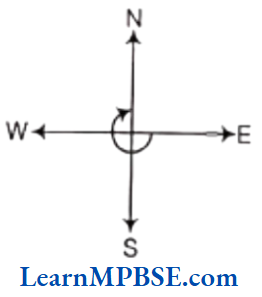
(2) Here, the turn from South to West is one right angle, from West to North is one right angle and from North to East is one right angle. So, W+ the turn from South to East is three right angles.
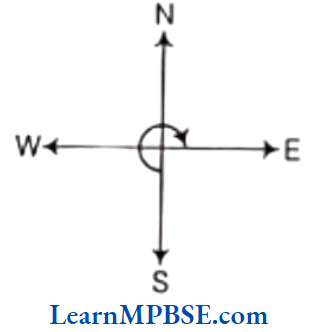
Hence, 3/4 of a revolution is required to turn from South to East.
(3) Here, the turn from West to North is one right angle, from North to East is one right angle. So, the turn from West to East is two right angles.
Hence, 1/2 of a revolution is required to turn from West to East.
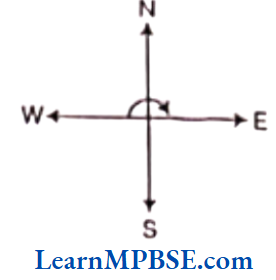
MP Board Class 6 Maths solutions
Question 2. The hour hand of a clock moves from 12 to 5. Is the revolution of the hour hand more than 1 right angle?
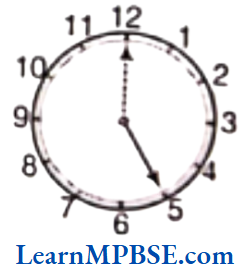
Solution. Yes, it is clear from the figure that hour hand makes one right angle from 12 to 3 and since 19 5 lies between 3 and 6. So, revolution of the hour hand is more than 1 right angle.
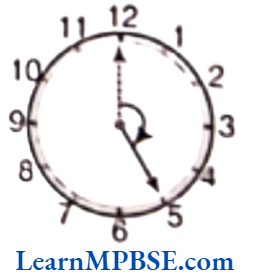
Question 2. What does the angle made by the hour hand of the clock look like when it moves from 5 to 7. Is the angle moved more than 1 right angle?
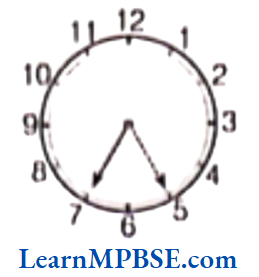
Solution. It looks like an acute angle. We know that hour hand of a clock makes a right angle to cover three digits as from 12 to 3, it makes a right angle
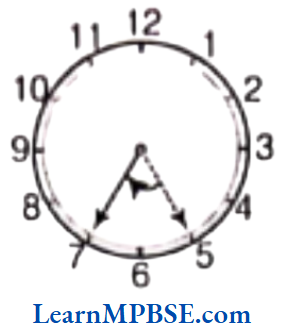
(∴ it covers three digits 1, 2 and 3). Here, hour hand moves from 5 to 7 (covers only two digits 6 and 7). So, the angle moved by hour hand is less than 1 right angle.
Question 3. Draw the following and check the angle with your RA (right angle) tester going
(1) from 12 to 2
(2) from 6 to 7
(3) from 4 to 8
(4) from 2 to 5
Solution.
(1) On checking the angle moved by an hour hand, while going from 12 to 2 by RA (right angle) tester, it is clear that it is less than 1 right angle.
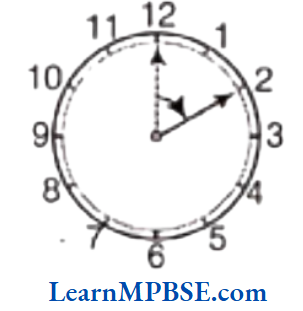
(2) On checking the angle moved by an hour hand, while going from 6 to 7 by RA (right angle) tester, it is clear that it is less than 1 right angle.
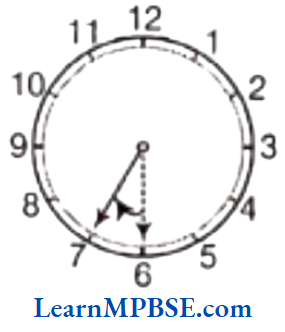
(3) On checking the angle moved by an hour hand, while going from 4 to 8 by RA (right angle) tester, it is clear that it is more than 1 right angle.
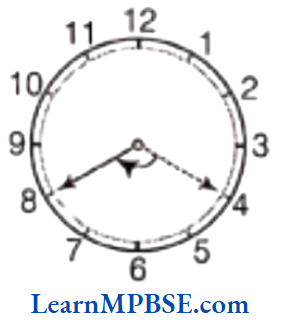
(4) On checking the angle moved by an hour hand, while going from 2 to 5 by RA (right angle) tester, it is clear that it is equal to 1 right angle.
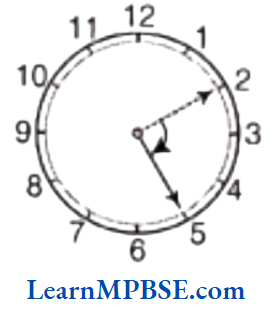
MP Board Class 6 Maths Solutions For Chapter 5 Understanding Elementary Shapes Exercise 5.3
Question 1. Match the following
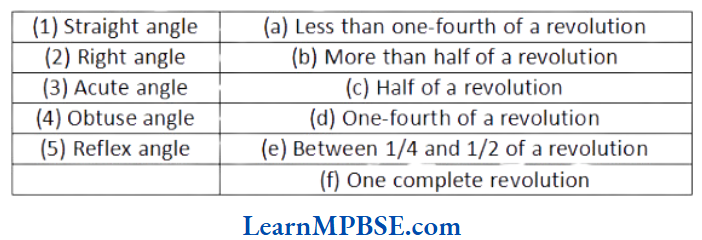
Solution. (1) Straight angle is half of a revolution.
(2) Right angle is one-fourth of a revolution.
(3) Acute angle is less than one-fourth of a revolution.
(4) Obtuse angle is between 1/4 and 1/2 of a revolution. (v) Reflex angle is more than half of a revolution.
So, (1) → (c), (2) → (d), (3) → (a), (4) → (e), (5) → (b)
MP Board Class 6 Maths solutions
Question 2. Classify each one of the following angles as right, straight, acute, obtuse or reflex.

Solution.
(1) Given angle is smaller than a right angle, so it is an acute angle.
(2) Given angle is more than a right angle, so it is an obtuse angle.
(3) Given angle is a right angle.
(4) Given angle is more than a straight angle, so it is a reflex angle.
(5) Given angle is a straight angle.
(6) Both angles are smaller than a right angle, so both these are acute angles.
MP Board Class 6 Maths Solutions For Chapter 5 Understanding Elementary Shapes Exercise 5.4
Question 1. What is the measure of
(1) a right angle?
(2) a straight angle?
Solution.
(1) The measure of a right angle = 90°
(2) The measure of a straight angle
= 2 × right angles = 2 x 90° = 180°
Question 2. Say true or false.
(1) The measure of an acute angle < 90°.
(2) The measure of an obtuse angle < 90°.
(3) The measure of a reflex angle > 180°.
(4) The measure of one complete revolution = 360°.
(5) If m∠A = 53° and m∠B = 35°, then m∠A > m∠B.
Solution.
(1) True, because the measure of an acute angle is always less than 90°.
(2) False, because the measure of an obtuse angle is always greater than 90°.
(3) True, because the measure of a reflex angle is always greater than 180° and less than 360°.
(4) True, because the measure of one complete revolution is equal to 360°.
(5) True, because the measure of ∠A is greater than ∠B.
Question 3. Write down the measures of
(1) some acute angles.
(2) some obtuse angles.
(give atleast two examples of each)
Solution. (1) We know that the measure of an acute angle is always less than 90″.
So, 45, 50, 55°, 60°, 65° all are acute angles.
(2) We know that the measure of an obtuse angle is always greater than 90° but less than 180°.
So, 120, 125, 135°, 140° all are obtuse angles.
Class 6 MP Board Maths question answers
Question 4. Measure the angles given below using the protractor and write down the measure.
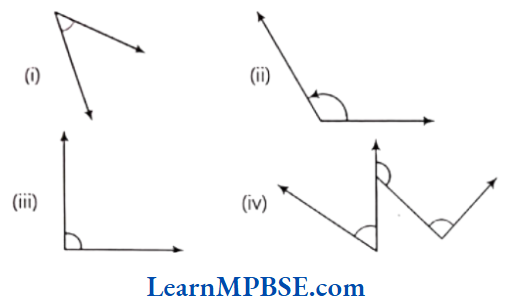
Solution. On measuring the given angles using protractor, we find that
(1) angle is 45°.
(2) angle is 125°.
(3) angle is 90°.
(4) angles are 60°, 125° and 90°, respectively.
Question 5. Which angle has a larger measure?

First estimate and then measure.
Measure of ∠A =
Measure of ∠B =
Solution. Observing the given angles, we find that ∠B > ∠A.
On measuring, we find that
Measure of ∠A = 40°
Measure of ∠B = 65°
∴ ∠B > ∠A
Question 6. From these two angles which has larger measure? Estimate and then confirm by measuring them.
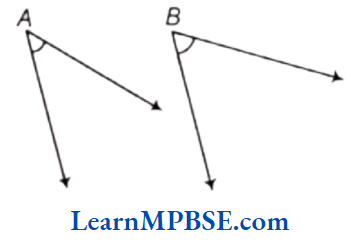
Solution. On observing, we find that ∠B > ∠A.
On measuring, we find that
∠A = 45° and ∠B = 60°
Thus, ∠B > ∠A
Question 7. Fill in the blanks with acute, obtuse, right or straight angle.
(1) An angle whose measure is less than that of a right angle is.
(2) An angle whose measure is greater than that of a right angle is
(3) An angle whose measure is the sum of the measures of two right angles is
(4) When the sum of the measures of two angles is that of a right angle, then each one of them is
(5) When the sum of the measures of two angles is that of a straight angle and if one of them is acute, then the other should be.
Solution. (1) acute angle
(2) obtuse angle
(3) straight angle
(4) acute angle
(5) obtuse angle
Question 8. Find the measure of the angle shown in each figure. (First estimate with your eyes and then find the actual measure with a protractor)

Solution. On estimating with eyes, the measure of angle shown in figure are as follows
(1) 45°
(2) 125°
(3) 60°
(4) 135°
Now, on measuring with the protractor, measure of angle shown in figure are as follows
(1) 40°
(2) 130°
(3) 65°
(4) 135°
Class 6 MP Board Maths Question Answers
Question 9. Investigate In the given figure, the angle measures 30°. Look at the same figure through a magnifying glass. Does the angle becomes larger? Does the size of the angle change?
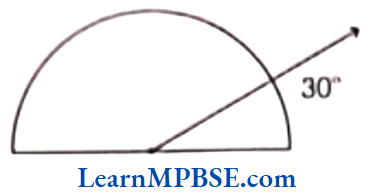
Solution. No, looking through a magnifying glass does not make the angle larger.
Also, the size of angle does not change.
MP Board Class 6 Maths Solutions For Chapter 5 Understanding Elementary Shapes Exercise 5.5
Question 1. Which of the following are models for perpendicular lines?
(1) The adjacent edges of a table top.
(2) The lines of a railway track.
(3) The line segments forming the letter ‘L’.
(4) The letter ‘V’.
Solution. (1) Yes, the adjacent edges of a table top make a model of perpendicular lines.
(2) No, the lines of a railway track does not make a model of perpendicular lines.
(3) Yes, the line segments forming the letter ‘L’ makes a model of perpendicular lines.
(4) No, the letter ‘V’ does not make a model of perpendicular lines.
Question 2. Let \(\overline{P Q}\) be the perpendicular to the line segment \(\overline{X Y}\). Let \(\overline{P Q}\) and \(\overline{X Y}\) Intersect at the point A. What is the measure of ∠PAY?
Solution. Given, \(\overline{P Q}\) is perpendicular to \(\overline{X Y}\) and \(\overline{P Q}\) and \(\overline{X Y}\) both intersect each other at the point A.
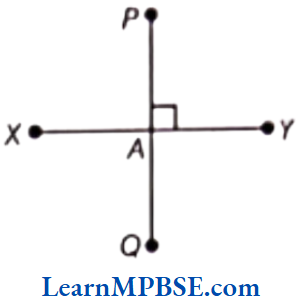
So, it is clear from the adjoining figure that ∠PAY=90°
Class 6 MP Board Maths Question Answers
Question 3. There are two set-squares in your box. What are the measures of the angles that are formed at their corners? Do they have any angle measure that is common?
Solution. We have two set-squares in our box. In one of them, angles are of 30°, 60°, 90° and in the other, angles are of 45°, 45°, 90°.

Clearly, they have one angle measure in common, which is
Question 4. Study the following diagram. The line l is perpendicular to line m.
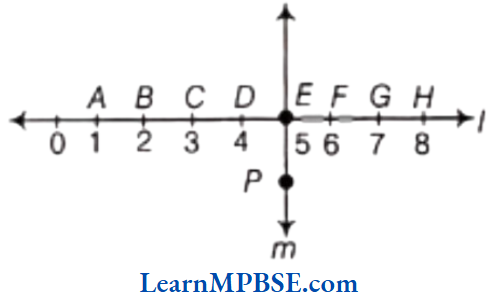
(1) CE = EG?
(2) Does PE bisect CG?
(3) Identify any two line segments for which PE is the perpendicular bisector.
(4) Are these true?
(a) AC > FG (b) CD = GH (c) BC < EH
Solution. (1) From given figure,
CE = CD + DE [CD = DE = 1 unit]
= 1 + 1 = 2 units
and EG = EF + FG [EF = FG = 1 unit]
= 1 + 1 = 2 units
∴ CE = EG 2 units
(2) Since, CE = EG
So, E is the mid-point of CG.
Thus, PE bisects CG.
(3) In the given figure, we can see that PE is perpendicular to the given line segment.
Since, DE = EF [each = 1 unit]
So, PE is the perpendicular bisector of DF.
Again, CE = EG [each = 2 units]
So, PE is the perpendicular bisector of CG.
(4) (a) Here, AC = AB + BC = 1 + 1= 2 units
[AB = BC = l unit]
and FG = 1 unit
∴ AC > FG is true.
(b) Here, CD = 1 unit and GH = 1 unit
∴ CD = GH is true.
(c) Here, BC = 1 unit
and EH = EF + FG + GH
= 1 + 1 + 1 = 3 units
∴ BC < EH is true.
MP Board Class 6 Maths Solutions For Chapter 5 Understanding Elementary Shapes Exercise 5.6
Question 1. Match the following:
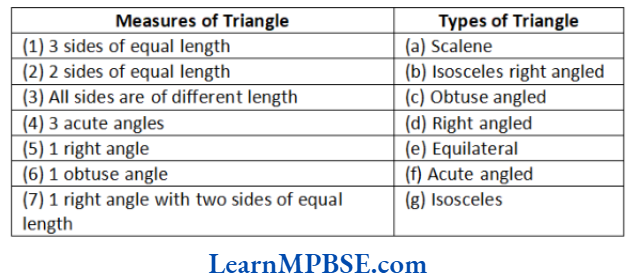
Solution. (1) → (e), (2) → (g), (3) → (a), (4) → (f), (5) → (d), (6) → (c), (7) → (b)
Question 2. Name each of the following triangles in two different ways. (you may judge the nature of the angle by observation)
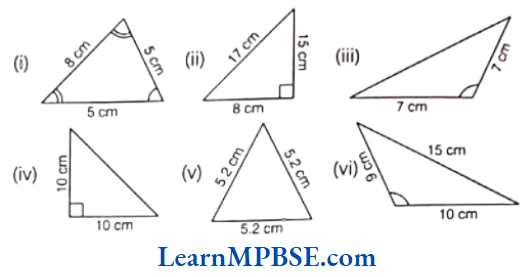
Solution. By observing the given triangles in two different ways, name of each triangle is given below
(1) In the given triangle, two sides are equal, so it is an isosceles triangle and all the angles are acute angles. So, it is an acute angled triangle also.
(2) In the given triangle, all the sides are different, so it is a scalene triangle and one angle is right angle. So, it is a right angled triangle also.
(3) In the given triangle, two sides are equal, so it is an isosceles triangle and one angle is an obtuse angle. So, it is an obtuse angled triangle also.
(4) In the given triangle, two sides are equal, so it is an isosceles triangle and one angle is right angle. So, it is a right angled triangle also.
(5) In the given triangle, all the sides are equal, so it is an equilateral triangle and all the angles are acute. So, it is an acute angled triangle also.
(6) In the given triangle, all the sides are different, so it is a scalene triangle and one angle is an obtuse angle. So, it is an obtuse angled triangle also.
Class 6 MP Board Maths Question Answers
Question 3. Try to construct triangles using matchsticks. Some are shown here.
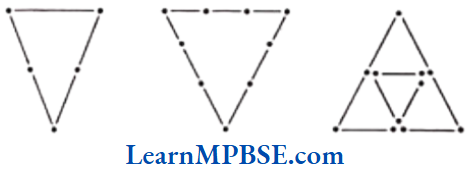
Can you make a triangle with
(1) 3 matchsticks?
(2) 4 matchsticks?
(3) 5 matchsticks?
(4) 6 matchsticks?
(Remember you have to use all the available matchsticks in each case)
Name the type of triangle in each case.
If you cannot make a triangle, think of reason for it.
Solution. (1) With the help of 3 matchsticks, we can make an equilateral triangle. Since, all three matchsticks are of equal length.
(2) With the help of 4 matchsticks, we cannot make any triangle because in this case, sum of two sides is equal to the third side and we know that the sum of the lengths of any two sides of a triangle is always greater than the length of the third side.
(3) With the help of 5 matchsticks, we can make an isosceles triangle. Since, we get two sides equal in this case.
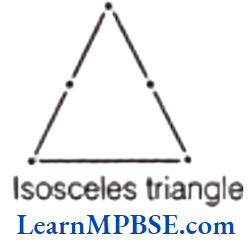
(4) With the help of 6 matchsticks, we can make an equilateral triangle. Since, we get three sides equal in this case.
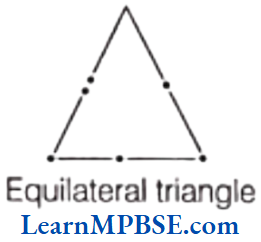
Chapter 5 Understanding Elementary Shapes Exercise 5.7
Question 1. Say true or false.
(1) Each angle of a rectangle is a right angle.
(2) The opposite sides of a rectangle are equal in length.
(3) The diagonals of a square are perpendicular to one another.
(4) All the sides of a rhombus are of equal length.
(5) All the sides of a parallelogram are of equal length.
(6) The opposite sides of a trapezium are parallel.
Solution. (1) True
(2) True
(3) True
(4) True
(5) False, because opposite sides of a parallelogram are of equal length and parallel.
(6) False, because a pair of opposite sides of trapezium are parallel and other pair of opposite sides are non-parallel.
Class 6 Maths Chapter 5 Solutions MP Board
Question 2. Give reason for the following
(1) A square can be thought of as a special rectangle.
(2) A rectangle can be thought of as a special parallelogram.
(3) A square can be thought of as a special rhombus.
(4) Squares, rectangles, parallelograms are all quadrilaterals.
(5) Square is also a parallelogram.
Solution. (1) We know that in a rectangle, opposite sides are equal and each angle is a right angle. If all its sides are equal, then it becomes square.
So, a square can be thought of as a special rectangle.
(2) We know that in a parallelogram, opposite sides are parallel as well as equal and opposite angles are equal. If its opposite angles are right angles, then it becomes a rectangle. So, a rectangle can be thought of as a special parallelogram.
(3) We know that in a rhombus, all four sides are equal and opposite sides are parallel. If its all angles are right angles, then it becomes a square. So, a square can be thought of as a special rhombus.
(4) We know that a polygon, which has four sides is called a quadrilateral. Square, rectangle and parallelogram also have four sides. So, these all are quadrilaterals.
(5) We know that in a parallelogram, opposite sides are parallel as well as equal and opposite angles are equal. In a square, opposite sides are parallel as well as equal and opposite angles are equal to right angle. So, a square is also a parallelogram.
Question 3. A figure is said to be regular if its sides are equal in length and angles are equal in measure. Can you identify the regular quadrilateral?
Solution. Yes, a square is a regular quadrilateral because all sides and angles of a square are equal.
Chapter 5 Understanding Elementary Shapes Exercise 5.8
Question 1. Examine whether the following are polygons. If any one among them is not, say why?

Solution. (1) It is an open figure. So, it is not a polygon.
(2) It is closed figure. So, it is a polygon with six sides i.e. hexagon.
(3) It is not made by line segments. So, it is not a polygon.
(4) It is made by two line segments and a curved line. So, it is not a polygon.
Class 6 Maths Chapter 5 Solutions MP Board
Question 2. Name each polygon.
Make two more examples of each of these.
Solution. (1) This polygon has four sides, so it is a quadrilateral. e.g.

(2) This polygon has three sides, so it is a triangle. e.g.
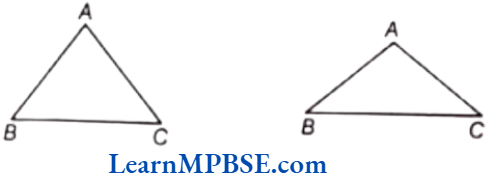
(3) This polygon has five sides, so it is a pentagon.
e.g.
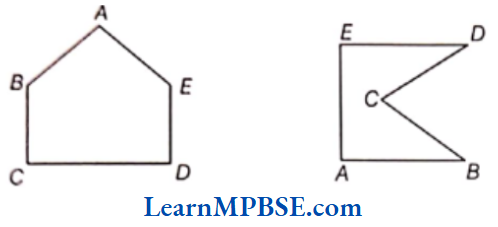
(4) This polygon has eight sides, so it is an octagon.
e.g.
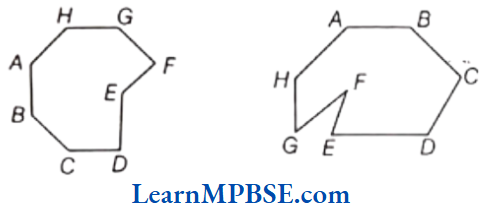
Question 3. Draw a rough sketch of a regular hexagon. Connecting any three of its vertices, draw a triangle. Identify the type of the triangle you have drawn.
Solution. Here, PQRSTU is a regular hexagon.
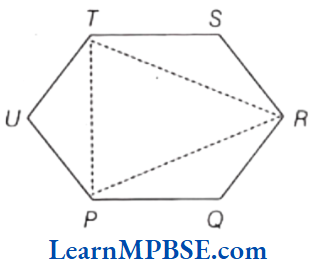
Joining its alternate vertices P, Rand T, we get ATPR, which is a regular triangle (since, all sides are equal).
Thus, the triangle so formed is an equilateral triangle.
Question 4. Draw a rough sketch of a regular octagon. (Use squared paper, If you wish).
Draw a rectangle by joining exactly four of the vertices of the octagon.
Solution. Here, ABCDEFGH is a regular octagon. Joining vertices G and D, we get \(\overline{G D}\). Again, joining H and C, we get H\(\overline{H C}\).
Thus, we get a rectangle HCDG.
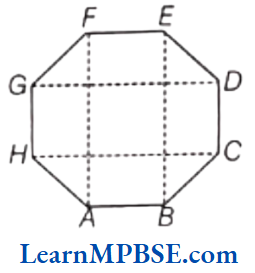
Again, by joining A, F and B, E, we can get another rectangle ABEF.
Question 5. A diagonal is a line segment that joins any two vertices of the polygon and is not a side of the polygon. Draw a rough sketch of a pentagon and draw its diagonals.
Solution. Rough sketch is shown below
Here, ABCDE is a pentagon.
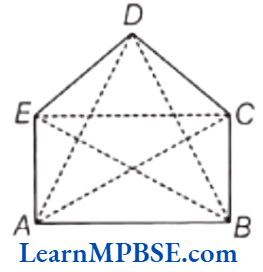
By joining any two vertices, we get diagonals as \(\overline{A C}, \overline{A D}, \overline{B D}, \overline{B E} and \overline{C E}\).
Chapter 5 Understanding Elementary Shapes Multiple Choice Questions
Question 1. Measures of the two angles between hour and minutes hands of a clock at 9 O’ clock are
- 60°, 300°
- 270°, 90°
- 75°, 285°
- 30°, 330°
Answer. 2. 270°, 90°
Question 2. If a bicycle wheel has 48 spokes, then the angle between a pair of two consecutive spokes is
- \(\left(5 \frac{1}{2}\right)^{\circ}\)
- \(\left(7 \frac{1}{2}\right)^{\circ}\)
- \(\left(\frac{2}{11}\right)^{\circ}\)
- \(\left(\frac{2}{15}\right)^{\circ}\)
Answer. 2. \(\left(7 \frac{1}{2}\right)^{\circ}\)
Question 3. If figure, if point A is shifted to point B along the ray PX such that PB = 2PA, then the measure of ∠BPY is
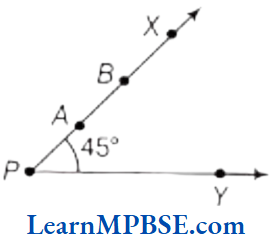
- greater than 45°
- 45°
- less than 45°
- 90°
Answer. 2. 45°
Class 6 Maths Chapter 5 solutions MP Board
Question 4. Where will the hand of a clock stop if it starts at 5 and makes \(\frac{1}{4}\) revolution clockwise?
- 7
- 8
- 9
- 10
Answer. 2. 8
Question 5. If you are facing South and turn through a straight angle in which direction will you face now?
- South
- North
- East
- West
Answer. 2. North
Question 6. Where will the hour hand of a clock stop if it starts at 7 and makes \(\frac{3}{4}\) revolution clockwise?
- 2
- 3
- 4
- 5
Answer. 3. 4
Question 7. The angle measure of one-fourth revolution is
- 360°
- 180°
- 90°
- None of these
Answer. 3. 90°
Question 8. How is the measure of an angle expressed?
- Protractor
- Compasses
- Degrees
- Centimeters
Answer. 3. Degrees
Question 9. If the sum of two angles is greater than 180°, then which of the following is not possible for the two angles?
- One obtuse angle and one acute angle
- One reflex angle and one acute angle
- Two obtuse angles
- Two right angles
Answer. 4. Two right angles
Question 10. 179° is an example of
- a straight angle
- an obtuse angle
- an acute angle
- a right angle
Answer. 2. an obtuse angle
Question 11. In figure, AB = BC and AD = BD = DC. Then, the number of isosceles triangles in the figure is
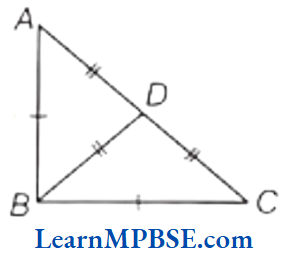
- 1
- 2
- 3
- 4
Answer. 3. 3
Question 12. The instrument to measure an angle is about
- ruler
- protractor
- divider
- compasses
Answer. 2. protractor
Question 13. The polygon with the least number of sides is a
- triangle
- rectangle
- pentagon
- hexagon
Answer. 1. triangle
Question 14. A rhombus with four right angles is known as
- rectangle
- square
- kite
- None of these
Answer. 2. square
MP Board Class 6 book solutions
Question 15. A polygon has the prime number of sides. Its number of sides is equal to the sum of the two least consecutive primes. The number of diagonals of the polygon is
- 4
- 5
- 7
- 10
Answer. 2. 5
Chapter 5 Understanding Elementary Shapes Assertion Reason
Question 1. Assertion (A) When we measure the length of a line segment by a ruler, there may be some errors due to angular viewing, these errors can be removed by making a line segment with the help of a divider.
Reason (R) The use of divider is better than a ruler.
(a) Both A and R are true and R is the correct explanation of A.
(b) Both A and R are true but R is not the correct explanation of A.
(c) A is true but R is false.
(d) A is false but R is true.
Answer. (b) Both A and R are true but R is not the correct explanation of A.
Question 2. Assertion (A) When the hand of a clock moves from one position to another, it turns through an angle.
Reason (R) The angle for one revolution is a complete angle.
(a) Both A and R are true and R is the correct explanation of A.
(b) Both A and R are true but R is not the correct explanation of A.
(c) A is true but R is false.
(d) A is false but R is true.
Answer. (b) Both A and R are true but R is not the correct explanation of A.
Chapter 5 Understanding Elementary Shapes Fill in the Blanks
Question 1. The hour hand of a clock stops at ….., if it starts at 12 and makes \(\frac{1}{2}\) revolution clockwise.
Answer. 6
Question 2. The angle formed in half-revolution is ………..
Answer. 180°
Question 3. Angle formed between the hands of a clock, when the time is 3 o’clock ……….
Answer. 90°
Question 4. A pair of opposite sides of a rectangle are ………… and ………….
Answer. Equal, parallel
Question 5. The number of diagonals in a hexagon is.
Answer. Nine
Chapter 5 Understanding Elementary Shapes True/False
Question 1. If the arms of an angle on the paper are increased, the angle increases.
Answer. False
Question 2. If the arms of an angle on the paper are decreased, the angle decreases.
Answer. False
Question 3. A horizontal line and a vertical line always intersect at right angle.
Answer. True
Question 4. Perpendicular bisector of the line segment is perpendicular to the line.
Answer. True
Question 5. A trapezium is a parallelogram.
Answer. False
Chapter 5 Understanding Elementary Shapes Match the Columns
Question 1. Match the Column 1 with Column 2 with their respective values.
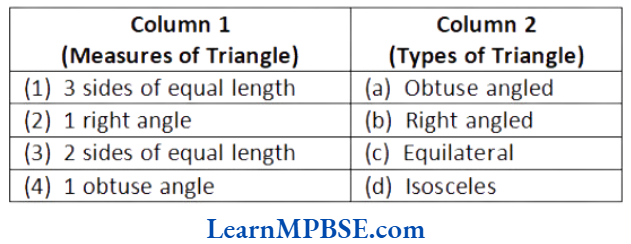
Solution. (1) → (c), (2) → (b), (3) → (d), (4) → (a)
Chapter 5 Understanding Elementary Shapes Case Based Questions
Question 1. A truss is a structural framework of wood or metal arranged in a pattern which is used to support roofs or bridges.
The structure of a truss made of iron rods is shown in the figure below.
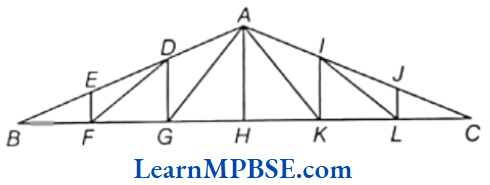
The rods EF, DG, AH, IK and JL are perpendicular to the base BC. A number of triangles are formed by the rods. In ΔABC, side AB = AC. In ΔAGK, all sides are equal and H is the mid-point of GK.
(1) Which type of triangle is ABC?
(a) Scalene
(b) Isosceles
(c) Equilateral
(d) Right-angled triangle
(2) Is ΔDGF a right-angled triangle? Justify your answer.
(3) Is AH the perpendicular bisector of line segment GK? Justify your answer.
(4) The sides of ΔIJL are of length 3 m, 4 m and 5 m. Is ΔIJL an isosceles triangle? Why?
Solution. (1) (b) Since, it given that in ΔABC, AB = AC, which means two sides of this triangle are equal. Therefore, it is an isosceles triangle.
(2) Yes, ADGF is a right-angled triangle because DG is perpendicular to BC, therefore ∠DGF = 90°, making ΔDGF a right-angled triangle.
(3) Yes, AH is the perpendicular bisector of line segment GK.
Since, it is given that H is the mid-point of GK and AH is perpendicular on it.
Therefore, AH is a perpendicular bisector of GK.
(4) If ΔIJL length of sides are 3m, 4m and 5m.
Therefore, ΔIJL is not an isosceles triangle because all the sides of this are unequal or there is no pair of equal sides.
MP Board Class 6 Book Solutions
Question 2. The figure below shows a combination of shapes.
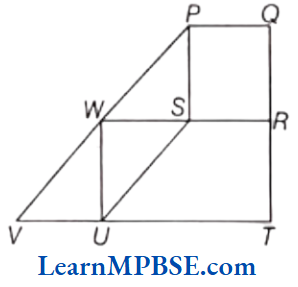
In the figure, US is parallel to WP and UV is parallel to QP.
PQRS is a square. WRTU is a rectangle. PSW and WUV are triangles.
(1) Arun joins Sand Q. SQ is an extension of US Which type of quadrilateral is PQUV? Justify your answer.
(2) Which of the following quadrilaterals is regular?
(a) PQRS
(b) PSUV
(c) RWUT
(d) PQTV
(3) Looking at the figure, Raji claims that, ‘PWUSis rhombus’. Do we have sufficient information to accept her claim? Justify your answer.
Solution. (1) Arun joins S and Q. SQ is an extension of US. PQUV is a parallelogram as its opposite sides are parallel.
(2) PQRS is a regular quadrilateral as its all sides are equal.
(3) No, there is no information on sides lengths of PWUS and opposite angles of PWUS.
Chapter 5 Understanding Elementary Shapes Very Short Answer Type Questions
Question 1. Write the name of triangle whose each angle is acute.
Solution. It is an acute angled triangle.
Question 2. Write the name of triangle whose all three sides are unequal in length.
Solution. A triangle which has all unequal sides is scalene triangle. Here, ΔABC is a scalene triangle.
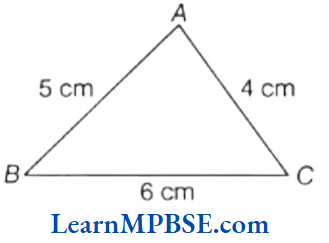
where, AB ≠ BC ≠ CA
Question 3. Write the name of polygon which has 5 sides.
Solution. A polygon which has 5 sides is pentagon.
Question 4. Find the number of sides in a quadrilateral. What can you say about the number of angles? Is it greater than the number of sides?
Solution. Number of sides in a quadrilateral is 4 and number of angles is also 4
No, the number of angles is same as the number of sides.
Question 5. If in a quadrilateral, one pair of opposite sides are parallel, then what is the name of such quadrilateral?
Solution. If one pair of opposite sides are parallel, then it is a trapezium. i.e. PS || QR
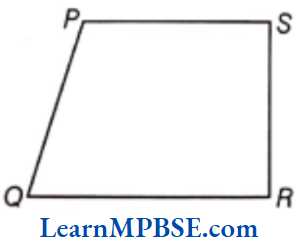
MP Board Class 6 Maths Solutions
Question 6. What is the difference between a square and a rhombus?
Solution. In a square, all angles are right angle whereas, in rhombus angles may right angle or not.
Question 7. The figure given below shows a tyre of a bicycle.
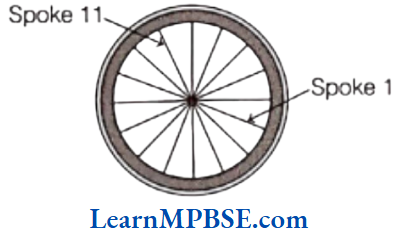
What type of angle does Spoke 1 make with Spoke 11?
Solution. Spoke 1 makes reflex angle and obtuse angle with Spoke 11.
Chapter 5 Understanding Elementary Shapes Short Answer Type Questions
Question 1. Will the lengths of line segment AB and line segment BC make the length of line segment AC in figure?

Solution. Here, \(\overline{A B}+\overline{B C}=\overline{A C}\)
Hence, the length of line segment \(\overline{A B}+\overline{B C}\) make the length of line segment \(\overline{A C}\).
Question 2. Will the measure of ∠ABC and ∠CBD make the measure of ∠ABD in figure?
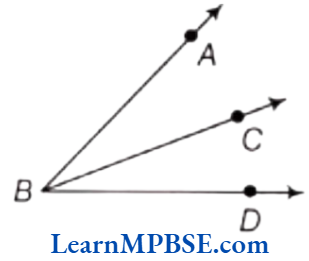
Solution. Here, ∠ABD = ∠ABC + ∠CBD
Hence, the measure of ∠ABC and ∠CBD makes the measure of ∠ABD.
Question 3. By simply looking at the pair of angles given below. State which of the angles in each pair is greater.
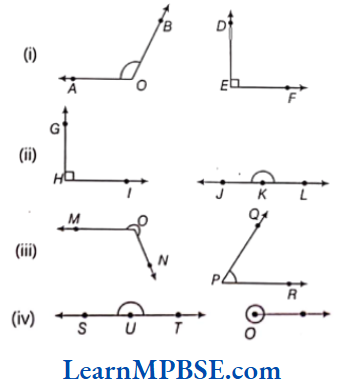
Solution. From the given figures, we can say that
(1) ∠AOB > ∠DEF
(2) ∠JKL > ∠GHI
(3) Reflex angle ∠MON > ∠QPR
(4) ∠0 > ∠SUT
Question 4. Which points in figure, appear to be mid-point of the line segments? When you locate a mid-point, name the two equal line segments formed by it.
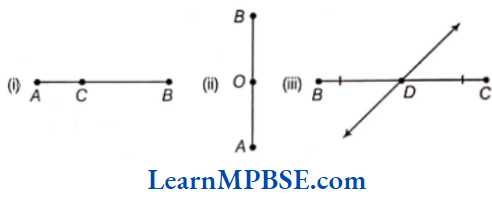
Solution. In the figure,
(1) There is no mid-point in \(\overline{A B}\).
(2) O is the mid-point of \(\overline{A B} \text { and } \overline{O A}=\overline{O B}\)
(3) D is the mid-point of \(\overline{B C} \text { and } \overline{B D}=\overline{C D}\)
Question 5. Is it possible for the same
(1) line segment to have two different lengths?
(2) angle to have two different measures?
Solution. (1) No, a line segment cannot have two different lengths.
(2) No, an angle cannot have two different measurements.
Question 6. State the type of angle in the following.
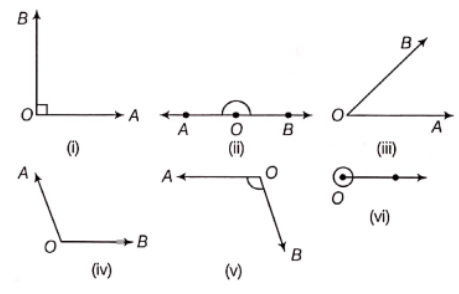
Solution. In the given figures, we have
(1) ∠AOB is a right angle.
(2) ∠AOB is a straight angle.
(3) ∠AOB is an acute angle.
(4) ∠AOB is an obtuse angle.
(5) ∠AOB is an obtuse angle.
(6) ∠O is a complete angle.
MP Board Class 6 Maths Solutions
Question 7. Using a ruler onlu, draw an acute, obtuse and reflex angle.
Solution. (1) Acute ∠AOB
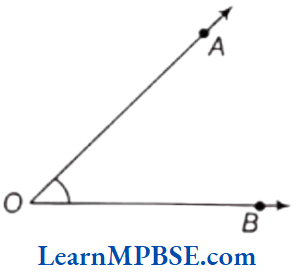
(2) Obtuse ∠POQ
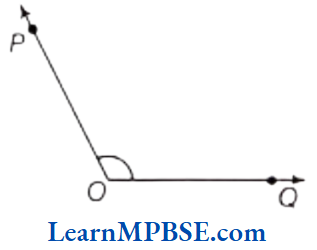
(3) Reflex ∠ROS
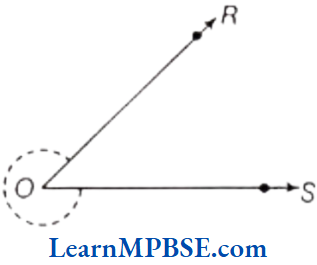
Question 8. Convert the following angles (in degrees) into fraction of right angle.
(1) 10°
(2) 20°
(3) 135°
Solution. We know that 1 right angle = 90°
i.e. 1°= \(\frac{1}{90}\) right angle
(1) \(10^{\circ}=\frac{10^{\circ}}{90^{\circ}}=\left(\frac{1}{9}\right) \text { right angle }\)
(2) \(20^{\circ}=\frac{20^{\circ}}{90^{\circ}}=\left(\frac{2}{9}\right) \text { right angle }\)
(3) \(135^{\circ}=\frac{135^{\circ}}{90^{\circ}}=\left(\frac{3}{2}\right) \text { right angle }\)
Question 9. Convert the following into degree.
(1) \(\frac{2}{9}\) right angle
(2) \(\frac{3}{4}\) right angle
Solution. We know that right angle = 90°
(1) \(\frac{2}{9} \text { right angle }=\frac{2}{9} \times 90^{\circ}=20^{\circ}\)
(2) \(\frac{3}{4} \text { right angle } \frac{3}{4} \times 90^{\circ}=675^{\circ}\)
Question 10. In the given figure, PQ ⊥ AB and PO = OQ. Is PQ, the perpendicular bisector of line segment AB? Why or why not?
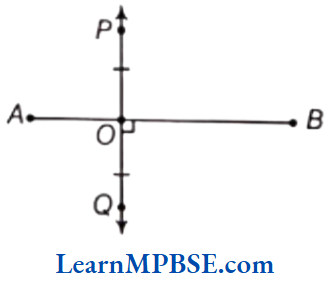
Solution. PQ is not the perpendicular bisector of line segment AB because AO ≠ BO.
[Note AB is the perpendicular bisector of line segment PQ].
Question 11. Draw any triangle of your choice, then draw all the three medians. Are they passing through one point?
Solution. According to the given information, APQR has medians \(\overline{P S}, \overline{Q T} \text { and } \overline{R N}\). Yes, these medians passing through one point ‘O’.
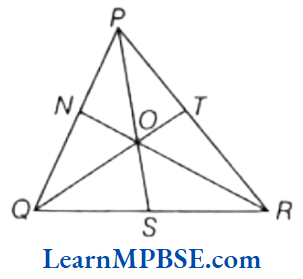
MP Board Class 6 Maths Solutions
Question 12. Which direction will you face, if you start facing East and make \(\frac{3}{4}\) of a revolution clockwise?
Solution. We face towards North.
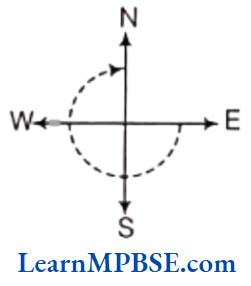
Question 13. If each side of a triangle is 6 cm. Name the type of triangle.
Solution. Given that, each side of a triangle is 6 cm.
Hence, it is an equilateral triangle.
Question 14. Find the measure of ∠POQ if PR ⊥ QT.
Solution. Here, ∠POQ = 90°

Chapter 5 Understanding Elementary Shapes Long Answer Type Questions
Question 1. Construct two line segments AB and CD of lengths 2.5 cm and 3.2 cm. Construct another segment EF, whose length is the sum of these two line segments. Measure the new length.
Solution. Now, first of all, we draw AB = 2.5 cm and CD = 3.2 cm

Now, we have to draw a line segment

∴ \(\overline{E F}=\overline{A B}+\overline{C D}\) = 2.5 + 3.2 = 5.7 cm
Hence, new length is 5.7 cm.
Question 2. Name the type of triangle and also draw it rough sketch.
(1) ΔABC; ∠A = ∠B = ∠C = 60°
(2) ΔABC; ∠B = ∠C = 50°
(3) ΔABC; ∠A = 45°, ∠B = 45°, ∠C = 90°
(4) ΔABC; ∠A = 50°, ∠B = 60°, ∠C = 70°
Solution. (1) Given, ∠A = ∠B = ∠C = 60°
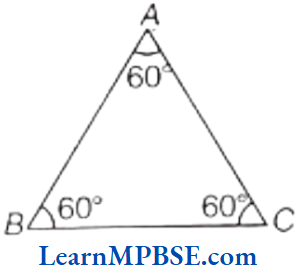
Hence, it is an equilateral triangle.
(2) Given, ∠B = ∠C = 50°
So, AB = AC
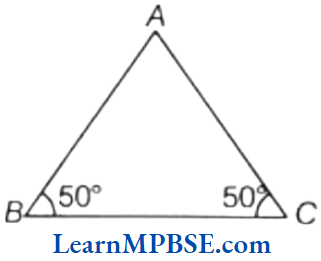
Hence, it is an isosceles triangle.
(3) Given, ∠A = 45°, ∠B = 45°, ∠C = 90°
So, AC = BC
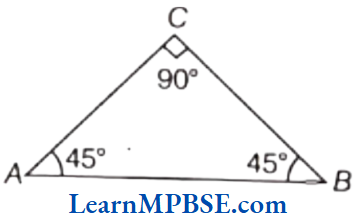
Hence, it is an isosceles right angled triangle.
(4) Given, ∠A = 50°, ∠B = 60°, ∠C = 70°
So, AB ≠ BC ≠ CA
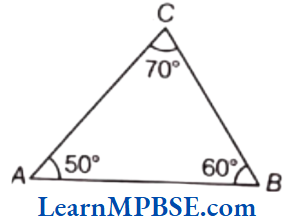
Hence, it is a scalene and acute angled triangle.
MP Board Class 6 book solutions
Question 3. During Maths lab activity, each student was given four broom sticks of length 8 cm, 8 cm, 5 cm, 5 cm to make different types of quadrilaterals.
(1) How many types of quadrilateral can be formed using four broom sticks?
(2) Name the types of quadrilateral formed.
Solution. Given, four broom sticks of length 8 cm, 8 cm, 5 cm and 5 cm.
(1) Three types of quadrilaterals can be formed.
(2) Name of the quadrilaterals are rectangle, parallelogram and kite.
Question 4. Name the following angles of figure using three alphabets
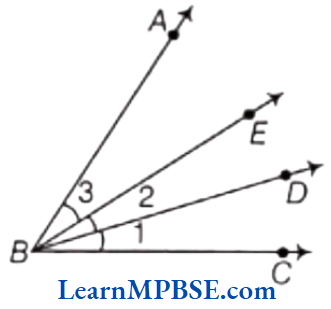
(1) ∠1
(2) ∠2
(3) ∠3
(4) ∠1 + ∠2
(5) ∠2 + ∠3
(6) ∠1 + ∠2 + ∠3
(7) ∠CBA – ∠1
Solution. Name of the angles are as follows:
(1) ∠1 = ∠CBD
(2) ∠2 = ∠DBE
(3) ∠3= ∠EBA
(4) ∠1 + ∠2 = ∠CBE
(5) ∠2 + ∠3 = ∠DBA
(6) ∠1 + ∠2 + ∠3 = ∠CBA
(7) Put the value of ∠CBA [∴ ∠CBA = ∠1 + ∠2 + ∠3]
Now, ∠CBA – ∠1 = ∠1 + ∠2 + ∠3 – ∠1
= ∠2 + ∠3 = ∠DBA [∴ ∠DBA ∠2+ ∠3]
Question 5. In which of the following figures
(1) perpendicular bisector is shown?
(2) bisector is shown?
(3) only bisector is shown?
(4) only perpendicular is shown?

Solution. (1) Perpendicular bisector means, a line is perpendicular to the another line and divides it into two equal parts.
Here, in figure (b), perpendicular bisector is shown.
(2) Bisector means, a line divides the another line in two equal parts.
Here, in figures (b) and (c), bisectors are shown.
(3) Only bisector is shown in figure (c).
(4) Only perpendicular is shown in figure (a).
MP Board Class 6 Maths Solutions
Question 6. Using the given information, name the right angles in the following figures.
(1) AC ⊥ BD
(2) AE ⊥ CE
(3) AC ⊥ CD
(4) OP ⊥ ABC
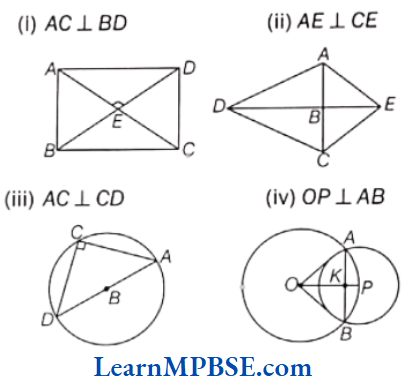
Solution. (1) Since, AC ⊥ BD, it means ∠E = 90°.
∴ ∠AEB, ∠BEC, ∠CED and ∠AED are right angles.
(2) Since, AE ⊥ CE, it means ∠E = 90°
∴ ∠AEC is a right angle.
(3) Since, AC ⊥ CD, it means ∠C = 90°
∴ ∠ACD is a right angle.
(4) Since, OP ⊥ AB, it means ∠K = 90°
∴ ∠AKO, ∠OKB, ∠BKP and ∠AKP are right angles.
MP Board Class 6 book solutions
Question 7. What conclusion can be drawn in each part of figure?
(1) DB is the bisector of ∠ADC.
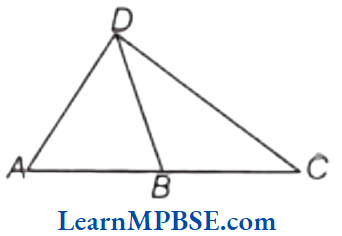
(2) BD bisects ∠ABC.
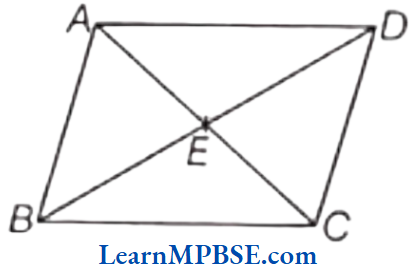
(3) DC is the bisector of ∠ADB, CA ⊥ DA and CB ⊥ DB.
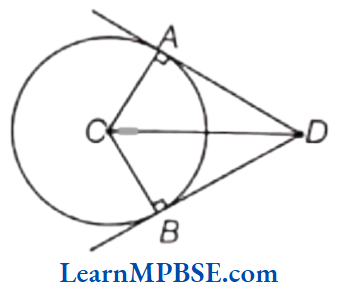
Solution. We know that bisector line divides an angle into two equal angles.
(1) Since, BD is the bisector of ∠ADC,
∴ ∠ADB = ∠BDC
(2) Since, BD bisects ∠ABC,
∴ ∠ABD = ∠CBD
(3) Since, DC is the bisector of ∠ADB and CA ⊥ DA and CB ⊥ DB
∴ ∠ADC = ∠BDC and ∠CAD = 90°, ∠CBD = 90°

